
- Customer Reviews
- Extended Essays
- IB Internal Assessment
- Theory of Knowledge
- Literature Review
- Dissertations
- Essay Writing
- Research Writing
- Assignment Help
- Capstone Projects
- College Application
- Online Class

Capstone Project: Definition, Types, Structure, and Examples
by Antony W
January 2, 2024
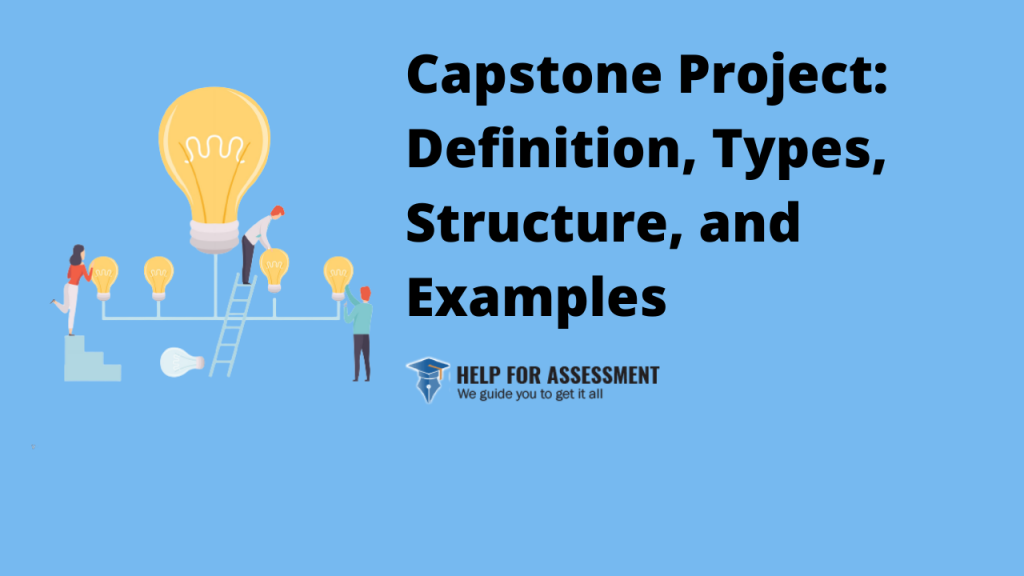
If you're reading this, chances are that you're in your final year of school and the words "capstone project" have come up somewhere in your first or second semester.
You're probably looking for a quick score on the topic - what it's about, a project template, or even a sample. If so, you're in the right place.
Before we get into it, you' need to know that you're in the hands of consummate capstone project experts.
Help for Assessment is composed of scholars at all levels of academic achievement including Masters and Ph.D., all inspired and motivated to help students like you achieve their academic goals. The expertise and experience we have spans years. Even better, this combined academic expertise is placed at your disposal. If your capstone research project is already giving you goosebumps, we will do it for you from scratch including the project proposal, research, write up, and final review before submission.
Remember, you can trust Help for Assessment to complete your capstone project successfully and earn you top grades. All you have to do is order the service here on our service page.
In the meantime, let us explore the definition of the capstone project, types of projects for students, and a sample capstone project.
What Is a Capstone Project?
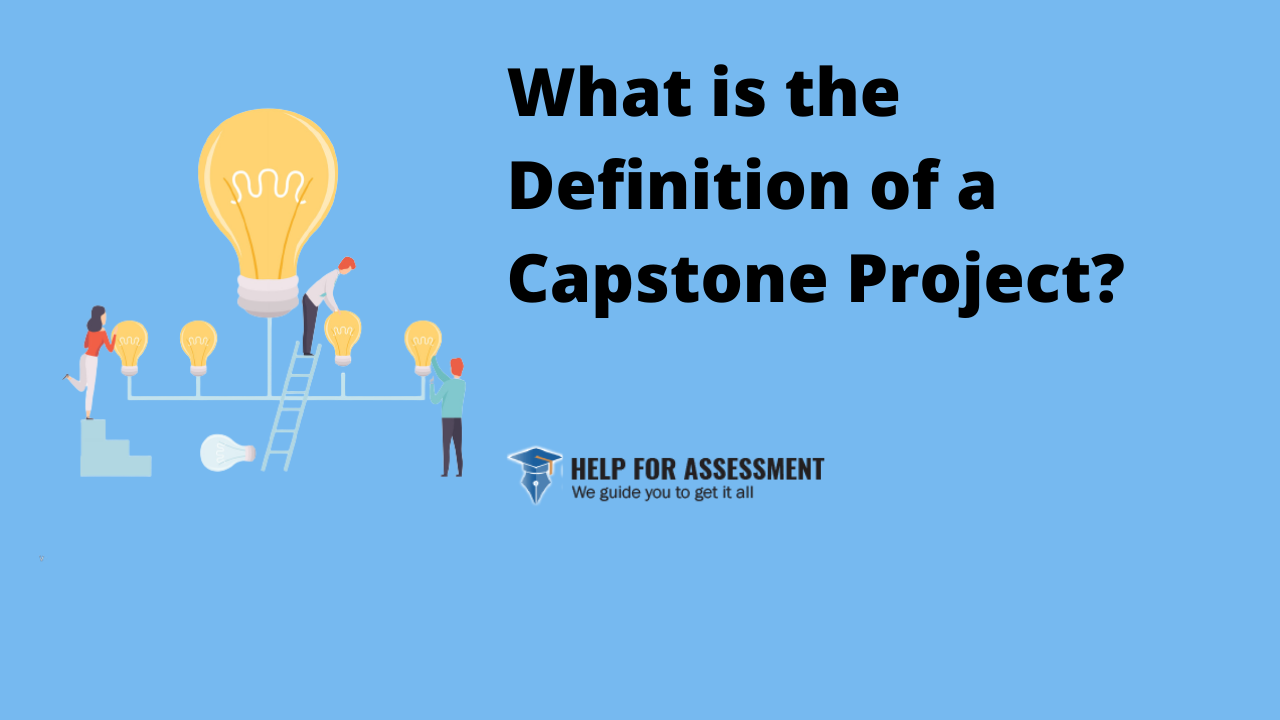
A capstone project in college is a final independent project undertaken in a program of study designed to assess the skills, knowledge, and expertise acquired by the student.
As the name suggests, it is the capstone or crowning achievement of academic life and the last class taken before graduation. It gives you the final credits required to pass the course, which is why every student must take the project.
Since it is designed to assess knowledge and skills gained in a particular discipline, capstone projects vary from school to school and discipline to discipline.
Such a project might involve something as simple as research on a topic, an evaluation of a new technique or method, development of a health program, research into a historical figure or event, or even composing a skit or theatre presentation.
No matter what kind of project you choose to undertake, the result is the same. You get to showcase your understanding of the coursework material learned and display your readiness to enter the professional world to start your career. It is a rewarding experience if done right, but can mess up your final year and possibly your graduation if you manage to mess it up.
Do you know that a successful capstone project also helps to land you lucrative jobs? That’s right, capstone projects are one of the ways potential employers find out just how learned, resourceful, and talented you are. Think of it as a kind of thesis.
Capstone projects are also called culminating projects, experience, senior exhibition, or other similar names. The project is usually self-directed, and most students find it a challenge to even come up with the right capstone project topic.
Capstone Project Vs. Thesis
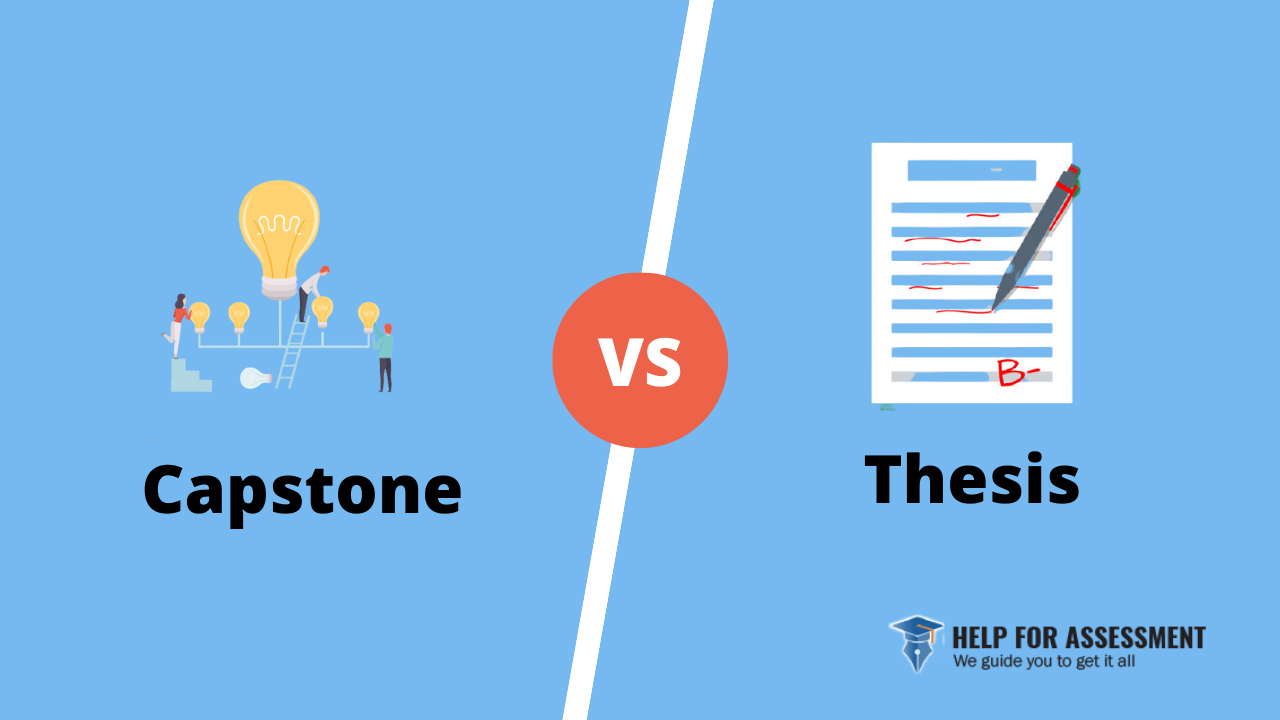
A capstone project and a thesis are both very similar in that they represent a final effort from the student just before graduation.
They are done in partial fulfillment of the requirements of the course being undertaken. The comprehensive approach and assessment involved are very similar, and sometimes the structure and methodology might overlap.
Both also have to be reviewed and approved by the institution and will remain in the public domain after publishing.
However, there are some important differences.
- A thesis is purely academic while a capstone project focuses more on the practical preparation of the student for the real world/job market.
- A thesis is guided by a research question resulting in the addition of new knowledge to the field, while a capstone project is guided by the practical importance of the project to the field.
- A thesis involves academic research and analysis, while a capstone project can be anything including a dance or film.
- A thesis is expected to be original and authentic, while a capstone project will have more loose requirements. You can borrow another person’s capstone project ideas , so long as you demonstrate your own advancement in the field.
- A capstone project will usually only have a brief write-up or report, while a thesis generates a detailed, extensive writeup.
- The final presentation of a thesis, called a defense, is meant to prove and show that you have mastered the subject. You are supposed to be a mini-expert in the field. A capstone project presentation comes off as a kind of exhibition where you showcase your project without having to defend it.
Types of Capstone Projects
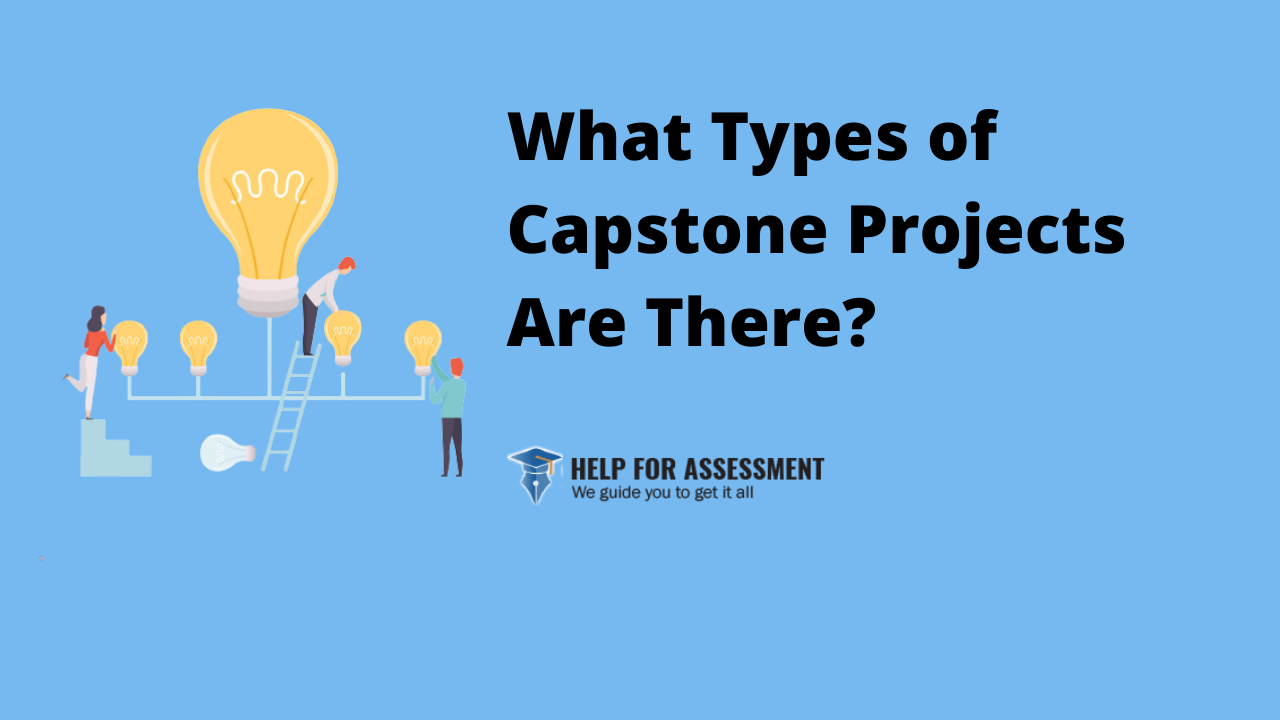
Capstone projects vary not just in the type of project, also in the level at which they are done.
There are projects for juniors and seniors in college as well as for postgraduate students.
Here are some examples of the forms of projects depending on the academic level.
- In-depth research projects.
- Developing the concept of a product, tool, or service.
- Expositions.
- Experiments.
Capstone projects can be conducted either individually or in a group.
However, the key thing is to make sure that the project proposal has been reviewed and approved by the instructor/panel/institution in charge before proceeding.
Senior Capstone Project
Senior projects are so called because they are done by high school students in their senior year.
Just like other projects, they represent a culmination of the coursework with an interdisciplinary application of knowledge and skills gained so far.
The project usually takes the better part of the final academic year and will have different parts to it, depending on the type of project chosen.
It will also require a presentation where the student(s) explain and describe the project to an audience, including their classmates.
Sample Capstone Project Outline
The write up for a project consists of several parts. However, even before starting the write-up, you need to do a few things:
- Come up with an idea for your project. What will be your subject matter, topic, or premise?
- Find sources for the project and review them beforehand to ensure that they will be of help to you.
- Come up with a step-by-step methodology for your project.
Using this information, you will then write a capstone project proposal for your project. It informs your instructor or review panel exactly what you intend to present so that they can approve or reject it.
Once approved, you can go on to the next stage. The final write-up has the following parts.
- A title page.
- Project outline.
- A description/abstract.
- Introduction
- Rationale/relevance/reason for doing the project.
- Objectives of the project.
- Procedures/methodology.
- Research and analysis.
- Evaluation of results and findings.
- Conclusion and future work/suggestions.
- Bibliography/works cited/reference list.
Note that the project is carried out in stages. Once approved, you will need to be submitting weekly or monthly status reports to your supervisor. After the project report is submitted, you will also have to make a presentation about the whole project.
This brief outline is only meant to be a rough guide. We have a much more detailed article detailing how you can do your capstone project, including a project template.
Capstone Project Examples
Help for Assessment has extensive experience when it comes to capstone projects of all kinds.
Whether it’s a high school project, a college capstone, or a senior capstone project, you can trust us to carry it out successfully for you.
You can check out various project samples here .
Get Help With Your Capstone Project
Capstone projects in every level of school are a make or break it deal. Given that they complete the graduation credits required, it makes sense to leave this important part of your coursework to experts.
We are proud to offer you a guide on how to write a capstone project here . If you need help, you can take advantage of our capstone project writing service at affordable, student-friendly rates with amazing discounts.
Check it out here and make your order to experience excellence, peace of mind, and success thanks to our stellar services.
About the author
Antony W is a professional writer and coach at Help for Assessment. He spends countless hours every day researching and writing great content filled with expert advice on how to write engaging essays, research papers, and assignments.
Created by the Great Schools Partnership , the GLOSSARY OF EDUCATION REFORM is a comprehensive online resource that describes widely used school-improvement terms, concepts, and strategies for journalists, parents, and community members. | Learn more »

Capstone Project
Also called a capstone experience , culminating project , or senior exhibition , among many other terms, a capstone project is a multifaceted assignment that serves as a culminating academic and intellectual experience for students, typically during their final year of high school or middle school, or at the end of an academic program or learning-pathway experience . While similar in some ways to a college thesis, capstone projects may take a wide variety of forms, but most are long-term investigative projects that culminate in a final product, presentation, or performance. For example, students may be asked to select a topic, profession, or social problem that interests them, conduct research on the subject, maintain a portfolio of findings or results, create a final product demonstrating their learning acquisition or conclusions (a paper, short film, or multimedia presentation, for example), and give an oral presentation on the project to a panel of teachers, experts, and community members who collectively evaluate its quality.
Capstone projects are generally designed to encourage students to think critically, solve challenging problems, and develop skills such as oral communication, public speaking, research skills, media literacy, teamwork, planning, self-sufficiency, or goal setting—i.e., skills that will help prepare them for college, modern careers, and adult life. In most cases, the projects are also interdisciplinary, in the sense that they require students to apply skills or investigate issues across many different subject areas or domains of knowledge. Capstone projects also tend to encourage students to connect their projects to community issues or problems, and to integrate outside-of-school learning experiences, including activities such as interviews, scientific observations, or internships.
While capstone projects can take a wide variety of forms from school to school, a few examples will help to illustrate both the concept and the general educational intentions:
- Writing, directing, and filming a public-service announcement that will be aired on public-access television
- Designing and building a product, computer program, app, or robot to address a specific need, such as assisting the disabled
- Interning at a nonprofit organization or a legislator’s office to learn more about strategies and policies intended to address social problems, such as poverty, hunger, or homelessness
- Conducting a scientific study over several months or a year to determine the ecological or environmental impact of changes to a local habitat
- Researching an industry or market, and creating a viable business plan for a proposed company that is then “pitched” to a panel of local business leaders
For related discussions, see authentic learning , portfolio , relevance , and 21st century skills .
As a school-reform strategy, capstone projects are often an extension of more systemic school-improvement models or certain teaching philosophies or strategies, such as 21st century skills, community-based learning , proficiency-based learning , project-based learning , or student-centered learning , to name just a few.
The following are a few representative educational goals of capstone projects:
- Increasing the academic rigor of the senior year. Historically, high school students have taken a lighter course load or left school early during their twelfth-grade year, which can contribute to learning loss or insufficient preparation for first-year college work. A more academically and intellectually challenging senior year, filled with demanding but stimulating learning experiences such as a capstone project, the reasoning goes, can reduce senior-year learning loss , keep students in school longer (or otherwise engaged in learning), and increase preparation for college and work.
- Increasing student motivation and engagement. The creative nature of capstone projects, which are typically self-selected by students and based on personal interests, can strengthen student motivation to learn, particularly during a time (twelfth grade) when academic motivation and engagement tend to wane.
- Increasing educational and career aspirations. By involving students in long-term projects that intersect with personal interests and professional aspirations, capstone projects can help students with future planning, goal setting, postsecondary decisions, and career exploration—particularly for those students who may be unfocused, uncertain, or indecisive about their post-graduation plans and aspirations.
- Improving student confidence and self-perceptions. Capstone projects typically require students to take on new responsibilities, be more self-directed, set goals, and follow through on commitments. Completing such projects can boost self-esteem, build confidence, and teach students about the value of accomplishment. Students may also become role models for younger students, which can cultivate leadership abilities and have positive cultural effects within a school.
- Demonstrating learning and proficiency. As one of many educational strategies broadly known as demonstrations of learning , capstone projects can be used to determine student proficiency (in the acquisition of knowledge and skills) or readiness (for college and work) by requiring them to demonstrate what they have learned over the course of their project
In recent years, the capstone-project concept has also entered the domain of state policy. In Rhode Island, for example, the state’s high school graduation requirements stipulate that seniors must complete two out of three assessment options, one of which can be a capstone project. Several other states require students to complete some form of senior project, while in other states such projects may be optional, and students who complete a capstone project may receive special honors or diploma recognition.
Most criticism of or debate about capstone projects is not focused on the strategy itself, or its intrinsic or potential educational value, but rather on the quality of its execution—i.e., capstone projects tend to be criticized when they are poorly designed or reflect low academic standards, or when students are allowed to complete relatively superficial projects of low educational value. In addition, if teachers and students consider capstone projects to be a formality, lower-quality products typically result. And if the projects reflect consistently low standards, quality, and educational value year after year, educators, students, parents, and community members may come to view capstone projects as a waste of time or resources.

Alphabetical Search

Online Students
For All Online Programs
International Students
On Campus, need or have Visa
Campus Students
For All Campus Programs
What is a Capstone Project in College?

The capstone project in college is the apogee, or completion marker, of a student's coursework leading to the culmination of their program with a degree in their chosen field of study. The original definition of a capstone focuses on the actual stone placed at the top of a wall or building, marking the successful completion of the structure. It's a significant and celebrated piece of architecture, considered to be the most important of an entire construction project.
"(Capstone projects are) the apex of all a student's work done throughout their college career," said Dr. Jeff Czarnec , a social sciences adjunct online and on-campus at Southern New Hampshire University (SNHU). Retired after 23 years in law enforcement, Czarnec served as an associate dean of criminal justice and social sciences at SNHU for nearly a decade. He now leverages his extensive background to teach social sciences, enriching the academic experience with his practical insights.
When entering a capstone course, there's an expectation that you have all the necessary skills and knowledge to be successful.
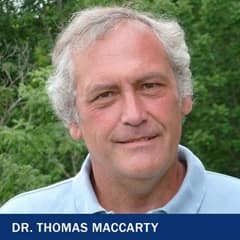
You have the opportunity to pick a research topic that is of interest to you and run with it. "After having to write research papers in all of their courses prior to (the capstone), the task is not one to dread, but to enjoy. It is their time to shine as students and to enjoy the journey," MacCarty said.
A capstone course is more than a potential degree requirement. It can serve as an opportunity to demonstrate knowledge mastery and creative thinking, which may help you stand out to potential employers.
What is Involved in a Capstone Project?

Each university, program and instructor may have different requirements — or models — for a capstone project. According to Czarnec, a general design might first include selecting a topic of interest that the instructor will approve.
Czarnec said that, depending on the program, a capstone may include anything from a video presentation or an architectural model to an art exhibit or short film; however, it almost always includes a paper demonstrating an introduction, theory, evaluation, research and individual issues relevant to the proposal.
"Students are expected to be ready to enter the world as professionals in their field upon completion of the capstone course," said MacCarty.
The time it takes to complete a capstone project usually depends on the course's length. If you're in an undergraduate online program at SNHU, for instance, your capstone course would take eight weeks to complete, Czarnec said.
Capstone courses are research-based, and you can choose your topic early on, allowing you more freedom to conduct research independently. Capstone topics usually align with a program's specific disciplines, too.
For example, in the social sciences realm, "our focus is on human behavior and cognition, which may be different from a capstone course in business or STEM," MacCarty said.
Find Your Program
Types of capstones.
There are many types of capstone projects that you could consider, and they vary from learner to learner, Czarnec said. "Some will investigate issues or phenomenon that they are familiar with either professionally, personally or courtesy of a discipline-related source, such (as) a police or human services agency," he said.
In a nutshell, a rough outline of a capstone, according to Czarnec, may look something like this:
- Select a topic and have it approved by the instructor
- Evaluate relevance to the proposal
- Perform necessary research
- Present results in the agreed-upon fashion
Czarnec said that if you're looking for a capstone topic, you may consider focusing on an area you're passionate about or you could also try to ask you instructor for some assistance. For example, Czarnec said that he can act as a guide, mentor, editor and research resource for his students to help them focus and narrow their search for a capstone topic.
Are Capstone Projects Difficult?
"Not necessarily," said Czarnec. "It does force you to be efficient and very specific to topic. No fluff. Straight forward. Razor sharp."
The capstone is more of an opportunity to catch your breath, he said, and to retrace and pull up what you have learned in a more stress-free environment .
"It helps validate students as learners," Czarnec said.
Depending on the major and course requirements, there may be opportunities to connect with outside contacts, not only to assist with the capstone project research and problem statement but also to provide a networking community .
"Not every research project is, nor should they be, the same," Czarnec said. "Everyone has a different approach."
What is the Difference Between a Thesis and a Capstone Project?
A capstone is similar to a thesis in that the starting point involves the strengths needed for a thesis or dissertation work. For example, you may need to consider the skeletal structure of research and form your theory, hypothesis and problem statement.
"While a capstone is certainly a scholarly piece of work and does share some aspects of a thesis, the time and detail that is required of a master's thesis is greater," MacCarty said.
A capstone paper may be 25 pages, whereas a thesis could be 100 or more. If you choose to further your education beyond a bachelor's degree, the capstone project could be an invaluable tool in preparing for a graduate thesis.
Capstone Projects are About Your Success
Capstones of all programs are leading you to the end game, Czarnec said. The goal is to develop you into a well-rounded thinker who can pull their work together in a coherent, articulate, well-organized fashion while considering the demands of the profession or vocation you're interested in.
The focus and intent of a capstone should be to create an effective device to assess and measure all that you've learned throughout your program in an aggregate fashion so you can demonstrate your life-long vocational skills in a nice, neat package.
"My goal is for students to leave the program confident about their skills and abilities," said Czarnec.
MacCarty said that capstone courses should be structured to support your success in fulfilling program requirements and allow you the opportunity to showcase your academic abilities and skills gained throughout your degree program.
A degree can change your life. Choose your program from 200+ SNHU degrees that can take you where you want to go.
Laurie Smith '14 is a writer, editor and communications specialist. Connect with her on LinkedIn .
Explore more content like this article
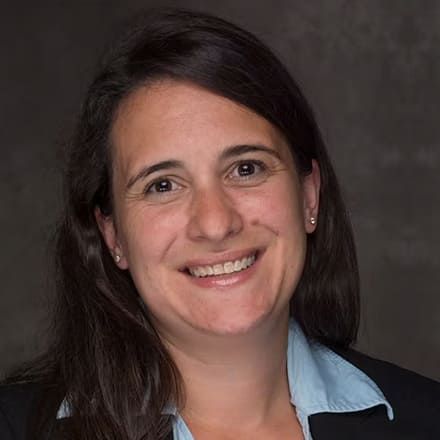
Academic Spotlight: Executive Director of Academic Effectiveness Dr. Meleena Eaton

Why It Pays to Advance from an Associate to Bachelor’s Degree
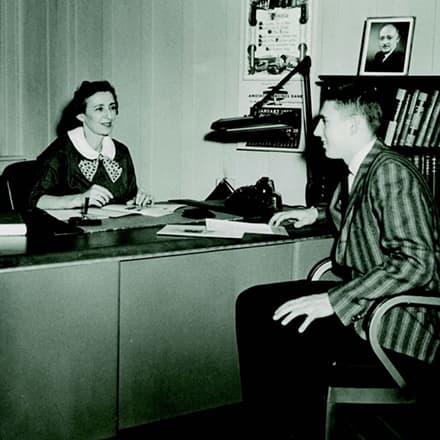
The Leadership and Legacy of Gertrude Shapiro
About southern new hampshire university.

SNHU is a nonprofit, accredited university with a mission to make high-quality education more accessible and affordable for everyone.
Founded in 1932, and online since 1995, we’ve helped countless students reach their goals with flexible, career-focused programs . Our 300-acre campus in Manchester, NH is home to over 3,000 students, and we serve over 135,000 students online. Visit our about SNHU page to learn more about our mission, accreditations, leadership team, national recognitions and awards.
Designing Capstone Experiences
Main navigation.

Starting with the graduating class of 2025, all Stanford undergraduates are required to complete a capstone project as part of their major (see capstone.stanford.edu ).
Capstones have been identified as a high-impact educational practice , providing opportunities for students to integrate and apply what they have learned during their major courses of study, strengthen relationships with instructors and mentors, and experience a range of personal and practical benefits.
CTL is excited to support departments and programs in the implementation of capstones. For all questions, email Kenneth Ligda at [email protected] , or file a CTL consultation request .
Exemplary capstone projects at Stanford
Capstones may take many forms, ranging from honors theses to community projects, seminars to group projects, e-Portfolios to research papers.
Many models for successful capstones already exist across Stanford departments and programs. Here, we provide a few exemplars to give a sense of both the possibilities and practicalities in this work.
Each of these capstone exemplars excel in two critical areas:
- providing opportunities for student-guided learning
- structuring experiences to help students meet challenging goals.
Through the capstone, students are often tasked with open-ended questions that push them to find novel or original answers. This offers students a unique opportunity to explore their own interests and direct their own learning. Whether students work on a team-based or individual project, they must use the knowledge and skills they have gained throughout their education to tackle complex problems that are often interdisciplinary in nature.
Preparing students for this kind of work can be challenging. A good place to start is with the learning goals from our capstone exemplars. The instructors identify important learning goals for their students that will help them transition into independent work and guide their own learning throughout the capstone.
But what happens when a student struggles with these ambitious learning goals? The capstone exemplars also discuss how their capstones have evolved over time to provide students with continuous support and feedback to help them throughout their capstone experience. The instructors describe how their capstones are structured to ensure students have clear guidelines at the start of their capstone and multiple checkpoints to meet the intended capstone learning goals.

Urban Studies

Bioengineering

Religious Studies

Human Biology
CTL offers the Capstone Experience Design (CapED) program to all departments and programs conferring undergraduate major degrees.
CapED is a two-day intensive to focus efforts on designing a successful capstone experiences. Modeled after CTL’s renowned Course Design Institute (CDI), CapED provides departments and programs a collaborative environment in which to design capstone experiences for their majors. Teams or individuals are welcome, and may include faculty, lecturers, staff, and undergraduate majors.
In CapED, we apply current research in teaching and learning to design effective and inclusive capstone projects suitable for diverse student majors. Learning goals for CapED participants include:
- Articulating student learning goals for the capstone project
- Drafting a capstone curriculum aligned with capstone learning goals and the major curriculum
- Integrating research-based practices into the capstone curriculum
- Evaluating capstone design to ensure equity and inclusion for all majors
- Receiving feedback from mentors in departments/programs with a capstone project
CapED Workshops and Materials
We are not currently planning another instance of CapED, but if you or your department/program are interested, please contact Kenny Ligda, [email protected] , for workshop materials or for a customized offering for your group.
Capstone Projects for Nursing Programs

NurseJournal.org is committed to delivering content that is objective and actionable. To that end, we have built a network of industry professionals across higher education to review our content and ensure we are providing the most helpful information to our readers.
Drawing on their firsthand industry expertise, our Integrity Network members serve as an additional step in our editing process, helping us confirm our content is accurate and up to date. These contributors:
- Suggest changes to inaccurate or misleading information.
- Provide specific, corrective feedback.
- Identify critical information that writers may have missed.
Integrity Network members typically work full time in their industry profession and review content for NurseJournal.org as a side project. All Integrity Network members are paid members of the Red Ventures Education Integrity Network.
Explore our full list of Integrity Network members.
Are you ready to earn your online nursing degree?
Capstone courses function as a bridge between the end of school and the beginning of a career, allowing nursing students to put what they’ve learned into practice. As the name suggests, students complete capstones toward the end of their nursing training. Not every nursing program requires a capstone, but those that do generally culminate in a bachelor of science in nursing (BSN) or doctor of nursing practice (DNP) degree.
Each nursing program sets their own requirements. While capstone formats differ between programs, they typically consist of an evidence-based practice formal paper or presentation. Students might complete their capstone projects as team leaders, and BSN candidates may present their papers to a faculty panel. Projects could include case studies, program evaluations, and policy analyses.
The focus on evidence-based practice allows students to apply research and experiential evidence toward solving a healthcare problem. For example, candidates may develop intervention strategies that promote health, improve outcomes, enhance quality of life, and foster safe practices for patients.
Capstone goals center on the application of knowledge gained during nursing training programs, including topics related to leadership , management, research, theories, and evidence-based practice, along with the strategies needed to transition from students to baccalaureate-level nurses.
Choosing Your Nursing Capstone Topic
When selecting a capstone topic, students should evaluate their interests, strengths, and weaknesses, along with their chosen nursing specialty area. Luther College recommends that students with lower GPAs and weaker nursing skills consider a basic medical-surgical topic. Those with strong clinical skills and high GPAs might choose emergency or intensive care medicine, although some students might prefer outpatient topics, such as clinical services, long-term care, or public health. However, this is simply an example of one school’s approach, and readers should keep in mind that each school sets its own policies and recommendations.
Asking for guidance from faculty, supervisors, preceptors, and fellow students also helps narrow down capstone topics. Advisors can also provide assistance in choosing an appropriate capstone site, helping with questions of geographical location, facility size, patient population, and care delivery model.
Students develop and learn the skills needed to complete their capstones throughout their training. These include organization and time management, knowledge of evidence-based practice, writing, and critical thinking. They also learn to conduct literature searches, identify research designs, and evaluate evidence.
Completing Your Nursing Capstone
Capstone formats and completion times widely vary between programs. Students at Luther College and Purdue University Northwest complete their capstones in 4-5 weeks, while Ferris State University specifies a timeframe of 30 hours of online classes and 90 hours of applied project work. Case Western Reserve University’s capstone spans 10 weeks.
Regardless of the program, most students follow a PICO format for project proposal questions of inquiry: population, intervention, comparison or condition, and outcome.
Some universities allow capstone projects to be completed in teams, in which students develop and implement the project. Capstone components may include defining the project and the team leader’s role, selecting team members, and formulating the project plan.
In addition to the skills previously referenced, such as knowledge of evidence-based care, critical thinking, and effective writing, capstone courses hone leadership and management abilities These include mastering therapeutic communication, applying leadership and management concepts, and developing collaborative relationships and working on multidisciplinary teams.
Presenting Your Nursing Capstone
The capstone process culminates in a paper or presentation that measures students’ skills in communication, information dissemination, and application of evidence-based practice skills. Members of the public may attend.
Utilizing the poster format, students commonly use three panels to illustrate: (1) the background, problem, and purpose; (2) methodology; and (3) 2-3 key findings and implications. Students who present using PowerPoint on a laptop or other device should pay attention to time limits, planning for one slide per minute, and verify that equipment and internet connectivity are available.
Visuals like graphs, figures, and bullet points are more effective than large blocks of text . Students should practice presenting in front of others to ensure that they thoroughly know their content and can answer questions. Backing up a copy of a PowerPoint presentation and printing out copies or transparencies guards against last-minute glitches.
How is a Nursing Capstone Graded?
Capstone grading methods differ between programs, with some issuing letter grades and others using a pass/no pass system. Grades typically hinge on a percentage basis of the project’s written sections, the final proposal, and the presentation. Faculty evaluate how students execute the capstone course objectives, which may include the following:
Students’ presentation skill evaluation criteria include exhibiting thorough preparation and knowledge of the subject matter, clear and concise communication, adherence to any time limits, ability to answer questions and cite references, and persuasiveness.
What is the Difference Between a Nursing Capstone and a Thesis?
Students complete capstones individually or in groups, while thesis projects must be done alone. Capstone project time lengths span between four and 12 weeks, while graduate students work on their thesis projects throughout their 2- to 3-year programs. Graduate thesis courses generally take place over 1-2 semesters to keep students on track.
Finally, capstone topics evaluate current issues and theories; thesis students incorporate existing case studies and literature while exploring and arguing for their own original research. Some schools require students to publish their thesis papers in a healthcare journal.
Reviewed By:
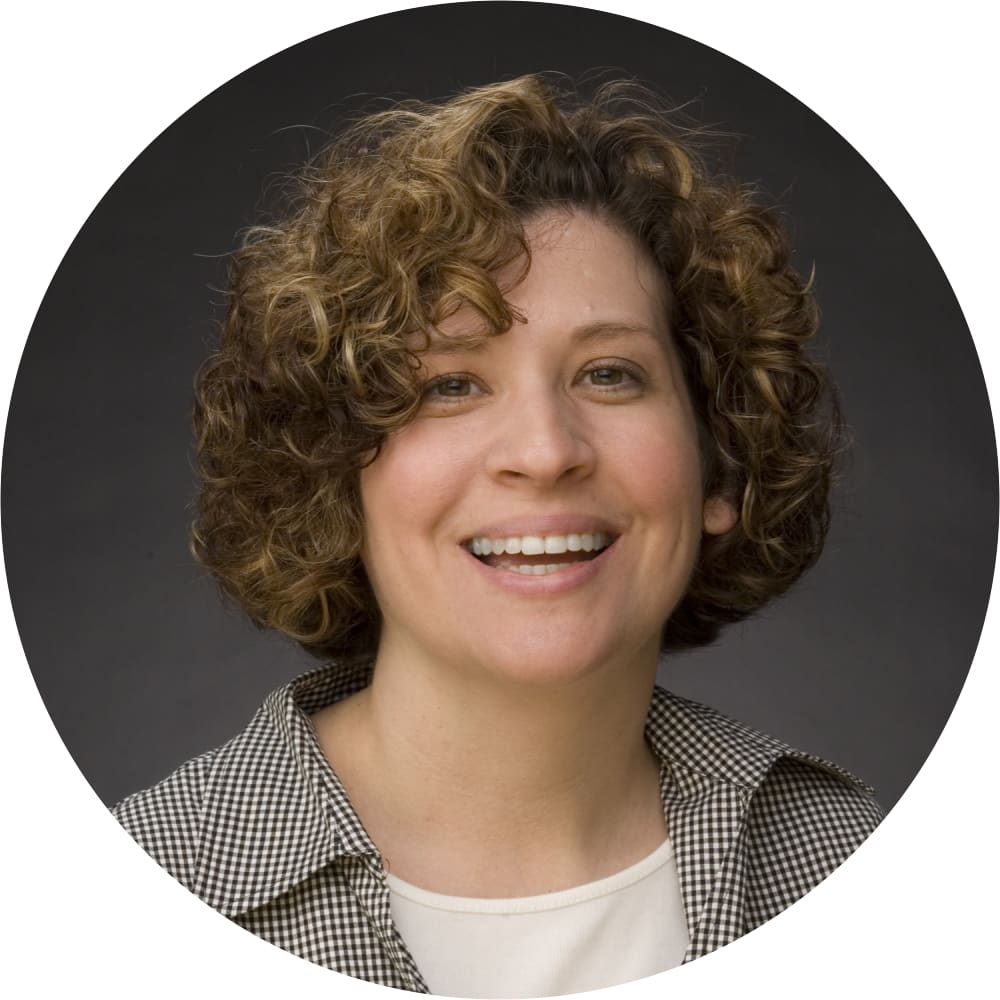
Theresa Granger
Theresa Granger, Ph.D., MN, NP-C With over two decades of teaching and clinical practice as a family nurse practitioner, Dr. Granger is an expert in nursing education and clinical practice at all levels of education (associate, baccalaureate, and graduate). She has published and lectured extensively on nursing education and clinical practice-related content. Her expertise ranges from student advising and mentoring to curricular and content design (both on ground and online) to teaching and formal course delivery. Dr. Granger is one of the founding faculty members of the University of Southern California’s first ever fully online graduate family nurse practitioner program .
Whether you’re looking to get your pre-licensure degree or taking the next step in your career, the education you need could be more affordable than you think. Find the right nursing program for you.
You might be interested in

Best Online Nursing Programs and Degrees
Overwhelmed by the abundance of online nursing programs? This guide can help you navigate the possibilities and narrow down the options.

Nurse Practitioner Career Overview

Certified Nursing Assistant (CNA) Career Overview
- Utility Menu
Guide to the ALM Capstone Project
Customstyles.
- Course Catalog
- Research Methods
There are a number of ways to conduct research for your capstone topic, but everyone must start with the literature review in order to learn what has already been published on your topic. Because this step is so important, we've created an entire section on this topic (please see Choosing a Topic, Literature Reviews ).
If your research methods will include the use of human subjects, please see the section on the Use of Human Subjects .
The following are research methods commonly used in capstone research:
Case studies. Case studies are in-depth investigations of a single individual (noteworthy sustainability leader), a group (activist), or event (United Nations Framework Convention on Climate Change). Reading prior case studies is a must to inform your design. Reading case studies may also lead you to sustainability professionals who authored the published work. These experts could become part of your own exploration of the topic. Case study is a formal research method with a specific structure. For an introduction, visit Basics of Developing a Case Study from the Free Management Library and visit MIT Sloan Learning Edge and Harvard Kennedy School for examples of quality case studies.
Interviews . You may want to conduct interviews with experts in the field on a specific topic, such as wave energy or clean water regulation. Sustainability professionals have a wealth of information and are ordinarily happy to support beginning scholars. Your capstone reader and your capstone instructor can help make introductions through their own networks. Interviews are not simple tasks. You'll need to learn how to conduct interviews in such a way that avoids bias and elicits data that can be used for analysis. For an introduction, visit General Guidelines for Conducting Research Interviews from the Free Management Library.
Surveys . Conducting a survey is another way to gather research on your topic. Ordinarily, this method is chosen when you want to gather information from a large data set. Survey design is also not a straightforward task. For an introduction, visit the Harvard University Program on Survey Research.
Program evaluation . You may also consider in-depth and detailed evaluation of an aspect of a specific organization's sustainability project to understand if and how it met its intended goals. For an introduction, visit Evaluation Activities in Organization from the Free Management Library.
Life Cycle Sustainability Assessment . As a sustainability student, it is very likely that this term is familiar to you. Understanding the environmental, social, and economic impact of our decisions is in essence what your degree is preparing you to do. Life cycle assessment is also a research method that you could employ in your capstone project. Visit the Life Cycle Initiative hosted by the UN environment for additional information.
- Course Sequencing and Timeline
- Precapstone Tutorial
- Choosing a Topic
- ENVR E-599 Past Capstone Titles and Examples
- Final Capstone Paper
- Use of Human Subjects
- ENVR 599A Consulting for Sustainability Solutions Capstone
- Frequently Asked Questions

- Understanding the Basics of a DNP Project
- How to Develop a DNP Project Using an Evidence-Based Approach
- Stages and Components of a DNP Project
- DNP Project Ideas
Sponsored School(s)
The Doctor of Nursing Practice DNP project represents the culmination of your doctoral studies and an opportunity for you to translate your acquired knowledge into practice. It is also the epitome of the practice-focused DNP and an essential part of the integrative practice experience. Preparing your DNP project is an exciting time, as it allows you to lay the groundwork for future scholarship while at the same time giving you a chance to make a potentially meaningful contribution to improving nursing practice and patient outcomes.
In a whitepaper published in August 2015 entitled The Doctor of Nursing Practice: Current Issues and Clarifying Recommendations , the AACN recommended that the DNP Project be referred to simply as the “DNP Project” as a way to distinguish it from final projects in other types of graduate programs. While the term DNP Project is still commonly used, it’s worth noting that schools and professional organizations are in the process of uniformly adopting the term “DNP Project.”
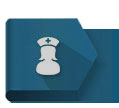
Here’s what you’ll want to know:
What is a DNP Project?
A DNP project is the umbrella term used to describe a scholarly project with the express purpose of translating evidence into practice. You may also hear it referred to as a final or research DNP project. Your DNP project will reflect your specialization/area of interest, allowing you to delve deep and create a project focused on clinical practice . You will use your DNP project to demonstrate mastery of your advanced nursing specialty.
Fortunately, given the wide breadth of clinical nursing practice, your choices for a DNP project are nearly limitless.
For example, your DNP project may be a practice portfolio that explores the impact or outcomes of nursing practice, or it may be a practice change initiative represented by a program evaluation. It may be a quality improvement project, a consulting project, or the evaluation of a new practice model. It may be a practice topic dissemination, a systemic review, or a manuscript submitted for publication—and that’s just to start.
Although DNP projects may take on various forms, depending on your college/university’s requirements and your area of advanced nursing practice, all DNP projects have three things in common: They all include planning, implementation, and evaluation components.
These components reflect the American Association of Colleges of Nursing’s (AACN) DNP Essentials, which states that a DNP project should be able to successfully integrate some or all of the following into practice:
- Focus on a change that impacts healthcare outcomes through either direct or indirect care
- Have a systems (micro-, meso-, or macro-level) or population/aggregate focus
- Implement the appropriate area of practice
- Include a plan for sustainability (e.g., financial, systems, or political realities)
- Include an evaluation of processes and/or outcomes
All projects should be designed so that processes/outcomes can be evaluated to guide practice and policy, and all should provide a foundation for future practice scholarship.
What is the Purpose of the DNP Project?
The goal of the DNP project is to inform the methods you will use to deliver care and educate others in your chosen population/community. You will use the DNP project to demonstrate your ability to lead and practice at the highest level of clinical nursing practice.
You will be asked to integrate a number of skills into your final project:
- Expertise in reflective practice
- Expertise in your area of interest
- Independent practice inquiry (identifying existing problems/needs in nursing practice and/or healthcare systems)
- The ability to evaluate, translate, and use research and evidence to improve health and quality of care outcomes
- Organizational and systems leadership skills (developing, implementing, and evaluating interventions to improve outcomes for diverse populations and/or communities)
- Knowledge of advanced healthcare policy, ethics, and law to develop a population-based program based on the best available and current evidence
Back to Top
This is your time to shine, so don’t let the task of choosing a DNP project stress you out.
Using your area of clinical expertise as a springboard, develop your project using an evidence-based process:
- Formulate a well-developed question: Describe an innovation or clinical inquiry; identify a problem/issue
- Review the literature to identify evidence-based resources that answer your question: Apply the best evidence from literature
- Assess the validity of your resources using evidence: Collect data using standard and acceptable methods/tools
- Apply that evidence: Define outcomes to be measured upon implementation
- Implement outcomes and/or analyze results: Re-evaluate the application and identify areas for improvement
An example of how one DNP student followed this 5-step evidence-based process to develop a change project with the goal of increasing vaccination among healthcare personnel working in a college:
Step 1. A change project was initiated to increase influenza vaccination among healthcare personnel at a college
Step 2. Barriers to vaccination as well as factors that would help facilitate vaccination were identified using a pre-intervention questionnaire survey
Step 3. Interventions were planned based on the findings of the pre-intervention questionnaire survey
Step 4. Interventions were implemented
Step 5. The effectiveness of the interventions was assessed through a post-intervention survey
An example of how one DNP student followed this 5-step evidence-based process to develop a quality improvement project with the goal of reducing delays in treatment for patients with hand trauma:
Step 1. A quality improvement project was initiated to avoid delays in care for patients with hand trauma
Step 2. Over 2,000 consultations and notes from emergency room and urgent care departments were reviewed to assess adherence to guidelines for treating hand trauma
Step 3. Factors associated with a lack of adherence to treatment guidelines were identified
Step 5. Outcomes were assessed
Questions to Ask
One of the best ways to ensure your DNP project accomplishes your objectives is to ask yourself questions to make sure the project meets the required standards:
- Does my project focus on individuals, communities, populations, and/or systems?
- What problems/issues will my project address?
- Is my DNP project grounded in clinical practice? Will it solve problems or directly inform my practice?
- Will my project demonstrate mastery of DNP competencies achieved through my doctoral education?
- Is my project supported by evidence provided through existing literature?
- Does my project address outcomes associated with patients and healthcare?
- Does my project provide a foundation for future scholarship in nursing?
- Executive summary of the project
- Introduction to the project
- Description of the problem, how it is defined, and the clinical setting/environment and target environment
- Data supporting the existence of the problem
- Description of the creative approach to resolving the problem
The steps required to complete a DNP project will also vary somewhat from one program to the next. Generally speaking, DNP projects include the following stages:
- Student identifies a focus area for the DNP project.
- A Capstone Chairperson is selected based on mutual agreement of the student and faculty member and the clinical/scholarly interests and area of expertise of the faculty member. Note: Careful selection of a capstone chairperson is important, as the student and chairperson will develop a plan of study and work closely throughout the process .
- Student selects a Capstone Committee (usually includes at least three faculty members, one of whom is the Capstone Chairperson).
- Student earns eligibility to defend the capstone proposal (the proposal must be formally approved by all Committee members).
- Student works with Capstone Chairperson to develop the proposal, using the Committee in an advisory capacity, as needed.
- Student prepares and distributes the proposal defense to the Committee members.
- Student arranges a meeting of the Committee to discuss the proposal and to rule on its acceptability (Committee members ensure the proposal’s feasibility, clinical relevance, and quality.).
- Upon acceptance of the proposal, the student begins the process of implementing the DNP project (must receive administrative approval for all steps of the project).
- Student schedules the final defense of the DNP project upon completing the written project and upon getting approval from the Capstone Chairperson.
- Student distributes the final copy to the Committee members and prepares for the oral defense of the DNP project.
- Committee members critique the project, identify any changes or additional work to be done, and determine the outcome of the DNP project defense.
- Smoking Cessation Program for Patients with Coronary Artery Disease
- Safe Foot Care in African American Type 2 Diabetes
- A Community Based Approach to Promoting Nutritional Awareness and Improving Dietary Habits
- Standardized Procedure for Assessment and Documentation of Pain in Long-Term Care
- Evidence-Based Practice Update for Nurse Practitioners in Urgent Care
- Strategies to Improve Patient Flow in an Urgent Care Facility
- Empowering Community Health: A Faith-Based Approach
- A Medication Safety Education Program to Reduce the Risk of Harm Caused by Medication Errors
- Integrated Model of Dementia Care in a Nursing Home
- An Evaluation of a School-Based Asthma Protocol
- A Strategy to Reduce Distress Among Isolated Blood and Marrow Transplant Patients Post-Transplantation
- An Evidence-Based Toolkit to Prevent Meningococcal Meningitis in College Students
- An Evidence-Based Ovarian Cancer Education Toolkit: A Pilot Study
- Consequences, Prevention, and Treatment of Childhood Overweight and Obesity
- Prevalence of Symptoms in Multiple Sclerosis Patients
- Obesity Prevention in Young Children
- Predictors of the First-Year Nursing Student at Risk for Early Departure
- The Predictive Value of Second Trimester Blood Pressures on the Development of Preeclampsia
- Nursing Informatics Certification and Competencies: A Report on the Current State and Recommendations for the Future
- Development of a Web-Based Health Information Database and Call Center
- Translation of Autism Screening Research into Practice
- Effectiveness of Chronic Disease Self-Management Programs for Mentally Ill Inmates with Diabetes
- Optimizing Inpatient Heart Failure Education to Support Self-Care After Discharge
- Strategic Plan for a Patient-Centered Medical Home Adaptation
- Development of a Virtual Nursing Learning Lounge to Bridge the Practice Gap
- Leadership, Advocacy, and Policy: Development of a Professional Organization for Doctors of Nursing Practice
- Media Influence on Nutritional Choices in School-Age Children
- Interdisciplinary Simulation Training for Evidence-Based Obstetric Crisis Management
- A Web-Based Group Intervention for Patients with Recurrent or Metastatic Pancreatic Cancer
- Evaluation of Pain Management Practices Among Laboring Women
- A Multi-Method Approach to Evaluating Online Distance Learning in Nursing Education
- Effects of Health Education on Nutrition and Physical Activity of School Children
- Clinical-Academic Partnership Education and Socialization into the Nursing Role
- Development of a Strategic Plan for a Dedicated Education Unit and Clinical Teaching Associate Role
- A Strategic Plan for Promoting Health in the Hispanic/Latino Population through Internet-Based Social Networks
- A Criterion-Based Job Description and Performance Assessment for the Advanced Practice Nurse
- A Strategic Plan for the Development of an Inpatient Hospice Program
- Deploying a Geriatric Nurse Practitioner in an Emergency Department to Improve Outcomes for Geriatric Patients
- Implementing Evidence-Based Practice in an Acute-Care Hospital
- A Strategic Plan for the Development of a Model of Care for HIV Co-Infected Diabetics in an Inner-City Clinic
- Implementation of Routine HIV Testing for the Hospitalized Patient
- Development of an Evidence-Based, In-Patient Alcohol Detoxification Guideline for Culturally Diverse Adults
- Conducting a Randomized Household Survey in an Underserved Urban Community
- Fall Prevention in the Medical Surgical Setting
- A Comprehensive Systematic Review of the Influence of Transformational Leadership Style on Nursing Staff in Acute Care Hospitals

Onshape for Engineering Capstone Projects
Calculus. Physics. Chemistry. Statics. Thermodynamics. Fluid Dynamics. Programming.
These courses define the typical undergraduate experience for engineering students around the world . Thanks to this challenging lineup, also typical are late-night test-cramming sessions, long hours in the library puzzling over problem sets, crunching and re-crunching numbers for lab write-ups, and a few all-nighters where dinner consists of Mountain Dew and Snickers out of the vending machine.
Engineering undergraduate programs are notoriously grueling, but most culminate in a rewarding opportunity to show off all that you’ve learned through a senior capstone engineering project.
This time-honored tradition is an important step in cementing years of learning through applying knowledge in the design and execution of a novel self-directed capstone engineering project. While these projects are often undertaken by college students during the final year of an engineering program, more and more high schools are also introducing the concept as the culmination of a multi-year engineering or STEM curriculum.
What is a Senior Capstone Project?
In a capstone project, budding engineers must demonstrate that they have mastered their subjects and bring their knowledge to bear on a complex multi-disciplinary problem. An authentic capstone project involves students collaborating on a team to investigate a real-world problem, devising solutions within time and budget constraints, building and testing prototypes, collecting data to improve, and presenting and publishing their findings. In other words, perform as real engineers.
The most challenging aspects of completing a successful capstone project are both technical and organizational. A capstone project might be the first time a student must collaborate on a team, manage complex design data, and coordinate a months-long project schedule.
Cloud-Native CAD for Capstone Engineering Projects
Onshape is the tool that many professional engineers and engineering companies rely on to meet the challenges in capstone engineering projects and real life.
Let’s look at a few of the main challenges encountered by capstone project teams – as well as professional engineers, robotics teams , and extracurricular competition teams – and how Onshape, a cloud-native CAD platform , meets them.
CAD Data Management
Just about any engineering project, whether it is a Formula SAE car, an auto-focusing microscope, an autonomous drone, a carbon fiber bicycle frame, or a CubeSat , requires CAD data. CAD is the language of design, and designers in any field rely on it to develop, refine, and communicate their ideas.
The more complex the project, the more complex the CAD data. Even a moderately sized capstone project CAD model can contain hundreds of parts, assemblies, subassemblies, drawings, and other data. With traditional CAD, managing this data quickly becomes a full-time job. Keeping track of files, versions, and iterations can grind the design process to a halt.
Onshape seamlessly handles the data management for you, enabling engineers to spend their time designing. With Onshape , every action a designer makes is automatically saved in the cloud. When design milestones are reached, clicking a button creates an immutable snapshot of the design stored as a version .
Engineers will dream up new design directions or variants throughout the design process. With file-based systems, the idea of heading off in a new direction can be so daunting that engineering teams avoid it, stifling creativity. With Onshape, creating a branch to explore design ideas is easy and risk-free.
When teams embrace the power and flexibility of branching and merging, a project might entail dozens of branches as engineers organically try out ideas, add features, and investigate designs. This fearless design mode encourages pursuing new ideas without confusion or complications as the project evolves. Ideas formulated in design branches can be discarded or selectively merged into the main design workspace.
Assembly Management
For any engineering project, CAD data is essential, but as mentioned above, the size and number of CAD documents can become unwieldy. Onshape was built to solve this problem, and, done right, large or complex assemblies can be easily managed without slowing down the collaborative design process.
In particular, as projects grow in size and complexity, it is important to consider strategies to maintain document performance, reliability, and organization.
Maintaining Performance
With desktop CAD, as your model becomes bigger, you need a more powerful computer with more RAM and a faster processor.
Fortunately, Onshape is different. Onshape’s unique cloud-native architecture does all of the computation and processing. You can keep your existing laptop, even if it’s old or underpowered; Onshape will distribute all your data management and geometry calculations across various dedicated servers to provide a fast and responsive modeling experience.
Even with Onshape’s powerful servers at your disposal, it is still helpful to consider a couple of ways to keep your documents working at top speed.
For example, imagine your team is designing a 3D-printed airplane. It is possible to design the entire plane, including all structural elements, control surfaces, fasteners, motors, and electrical components, in a single Part Studio. As you can imagine, that Part Studio might eventually contain hundreds of features.
A problem can arise when you want to modify one of the features far up the feature list. After you change, all the features down the chain will have to regenerate. That takes time, regardless of how much server power you have.
Consider ways to divide your design across multiple Part Studios or even multiple documents as you design. When dividing across Part Studios, you can drastically reduce the size of your feature list. When dividing across documents, each document contains versioned reference to other documents, which can be a performance boost, particularly if the references are to versions of other documents.
Check out these help documents for more information:
Onshape Help page for Linking Documents
Onshape Help page for using Derived Features
Document History and Versions Learning Center Course
Linked Documents Learning Center Course
Performance Considerations
Increase Reliability
As mentioned above, one of the best ways to increase performance in Onshape is to divide a design across tabs or documents. With this process, you end up with Part Studios, assemblies, and documents with links or a reference to other Part Studios, assemblies, and documents. Onshape is built for this and can handle as many links as you need to facilitate your design process, but it is important to be intentional and strategic with this approach.
A common practice is for your top-level design to contain a Variable Studio and reference sketches. Variable Studios are tables of variables in Onshape that can serve as global variables to drive the rest of your design. Variable Studios can be shared across tabs within a document and even across documents.
Once your global variables are defined, sketches can be created that reference these variables to lay out your design's overall dimensions and structure. Then, as parts and assemblies are created, they can reference these master sketches. Updating the variables in your Variable Studio will reliably cascade through the rest of your design.
Better Organization
It takes considerable restraint, but it is important to avoid diving into a project once the initial design has been agreed upon. Effective teams take time to think through how the project should be organized. Think about the various subsystems of your project and how they are related. Also, consider your team's resources; who will be responsible for which parts of the project?
Branches were discussed above as a powerful way to manage CAD data. They also become invaluable tools for project organization . When you start modeling, consider making a development branch in Onshape where all the design work occurs. Set up regular meetings with your team to review branches and strategically merge parts of the design into the main branch as they are completed.
Branches are also useful for modeling various subsystems. A robot might have a drivetrain branch, a collector branch, and an arm branch. Each team can work on ideas within their branch without worrying about how their designs affect the other teams until the appropriate time.
As you can see, many effective ways to organize your CAD data exist. Take time to devise and communicate a system that will work for your team and your project.
Collaboration
Many capstone projects require students to work on teams and, without the right tools, can potentially complicate each stage of the engineering design process. Fortunately, Onshape was built for collaboration, and Onshape’s unique capabilities make it ideal for teams working together on a design.
With traditional CAD, one team member – sometimes just the one with the nicest computer – often owns the CAD data. And the more complicated the design gets, the less likely they are to try to share it, which would require zipping up files onto a thumb drive or sending them over email.
Onshape is cloud-native, meaning it runs on any device, be it a smartphone, tablet, Chromebook, Mac, or PC. And it doesn’t rely on files, so sharing designs is as easy as sending a URL or clicking the “Share” button. Regardless of physical location or computer horsepower, the entire team can work on the same design document simultaneously. Onshape democratizes the design process.
Onshape is the Right Tool for Large Projects
Few academic experiences are more rewarding than tackling and completing a large or complex collaborative design project. Whether it is a senior capstone project, a competition robot, or a solar race car, creating a real product of your own design is an authentic way to make your mark in the physical world and possibly make that world a little better.
Onshape is the right tool to get you there. From data management to collaboration to performance, Onshape is built to let teams design efficiently, effectively, and fearlessly.
Get Started with Onshape Education
Onshape for education brings CAD out of the computer lab and into the modern era.
Suggested Content
Want to create or adapt books like this? Learn more about how Pressbooks supports open publishing practices.
6. Supporting Your Study with Theoretical Constructs
Learning Objectives
By the end of this chapter, you will be able to:
- Describe the purpose of theoretical frameworks in capstone projects.
- Explain the purpose of conceptual frameworks in capstone projects.
- Explain the purpose of planning models in capstone projects.
- Compare and contrast theoretical frameworks, conceptual frameworks, and planning models.
- Describe at least two ways that a theoretical framework can strengthen a capstone project.
- Utilize strategies to select an appropriate framework or model for your capstone project.
This chapter addresses the relevance of selecting a theoretical framework, conceptual framework, or planning model to guide and support your capstone project. Theoretical and conceptual frameworks are compared and contrasted. Planning models are reviewed in the context of community program development. The connection between frameworks and/or planning models with literature reviews is explained. This chapter ends with a list of strategies that you can use to select an appropriate framework or model for your capstone project. It is important that you meet with your mentor, and capstone instructors to ensure your choice of framework or planning model is appropriate.
Introduction
The theoretical framework is a very important aspect of the capstone process. The importance of theory-driven thinking and acting is emphasized in relation to the selection of a topic, the development of the PIO/PICO question, the conceptualization of the literature review, the design approach, and the outcome/analysis plan of your capstone project. Consequently, the theoretical framework provides your capstone project with a grounding base, or an anchor, for the literature review, the methods, and the analysis for your capstone project. Your choice of a theory will provide structure to your entire capstone project. It provides a common worldview or lens from which to support your thinking on the problem and analysis of data (Grant & Osanloo, 2016). It is important to discuss this important aspect of your capstone project with your capstone instructors and mentor to ensure it is suitable for your particular capstone project.
What is a Theoretical Framework?
The theoretical framework is the “blueprint” for the entire capstone project. It serves as the guide on which to build and support your project. While theories are formulated to explain, predict, and understand phenomena, frameworks provide critical support for developing aspects of the capstone project over time. In many cases, theoretical frameworks are created to challenge and extend existing knowledge. The theory you select for your capstone project offers a conceptual basis for understanding, analyzing, and designing ways to investigate a problem. Therefore, the theoretical framework of a capstone project consists of the selected theory (or theories) that upholds your thinking with regards to how you understand and plan to investigate and review your topic, as well as the concepts and definitions from that theory that are pertinent to your topic (Grant & Osanloo, 2016).
The Importance of Theoretical Frameworks in Research
A theory is crucial for any capstone project to provide direction and to validate or disapprove a phenomenon. The role of the theoretical framework is to reduce your topic into two factors to simplify the concept:
- The identified need or problem
- The rationale for investigating the issue
A theoretical framework consists of concepts, together with their definitions, and existing theory/theories that are used for your capstone project. The theoretical framework is vital to all capstone projects in order to clarify an implicit theory in a manner that is more clearly defined (Refer to Table 6.1: How Theoretical Frameworks Strengthen a Study).
Table 6.1: How Theoretical Frameworks Strengthen a Capstone Project
Sources: DeIuliis, E. D., Bednarski, J. A., Bell, A., & DeAngelis, T. (2020). 3. In The entry level Occupational Therapy Doctorate Capstone: A Framework for the experience and project (pp. 41–55). Essay, SLACK Incorporated; Organizing academic research papers: Theoretical framework. (n.d.). Retrieved September 1, 2022, from https://library.sacredheart.edu/c.php?g=29803&p=185919%3A
Strategies for Selecting an Appropriate Theoretical Framework
Selecting an appropriate theoretical framework for your capstone project is an important process. The selection of a theoretical framework requires a deep and meticulous understanding of your problem, purpose, significance, and PIO/PICO question(s). It is important that all four constructs: the problem, purpose, significance, and research questions are tightly aligned and interwoven so that your theoretical framework can serve as the foundation for your work and guide your choice of capstone project design and data analysis. Our beliefs are influenced by assumptions, values, and ethics, which are all personal postulates; therefore, your fundamental beliefs will influence how you will examine and explore available information and research. For this reason, it is important to reflect on your own worldview and way of conceptualizing problems. It is important to remember that there is no one theory that fits best with any inquiry; therefore, it is important to select and provide a clear rationale for your theory choice to ensure that it aligns and supports the structure of your capstone project’s purpose, PIO/PICO question(s), significance, and design (Grant & Osanloo, 2016). (Refer to Table 6.2: General Guidelines for Selecting a Theoretical Framework).
Table 6.2: General Guidelines for Selecting a Theoretical Framework
Sources: Osanloo, A., & Grant, C. (2016). Understanding, selecting, and integrating a theoretical framework in dissertation research: Creating the blueprint for your “house”. Administrative issues journal: connecting education, practice, and research , 4 (2), 7; Organizing academic research papers: Theoretical framework. (n.d.). Retrieved September 1, 2022, from https://library.sacredheart.edu/c.php?g=29803&p=185919%3A
What is a Conceptual Framework?
A conceptual framework is a structure that the investigator believes can best explain the natural phenomenon being studied. Conceptual frameworks are linked with the concepts, empirical research, and important theories used in promoting or systemizing the knowledge promoted by the investigator. Simply, conceptual frameworks present an integrated way of looking at a problem under exploration (Adom, Hussein & Adu-Agye, 2018).
The Importance of Conceptual Frameworks in Research
Conceptual frameworks assist the investigator in identifying and constructing their global perspective on the occurrence to be explored. Conceptual frameworks are often used by investigators when existing theories are not applicable or sufficient in creating a firm structure for a project (Adom, Jussein & Adu-Agye, 2018). (Refer to Table 6.3: How Conceptual Framework Strengthen a Study).
Table 6.3: How Conceptual Frameworks Strengthen a Study
Sources: Adom, Dickson & Hussein, Emad & Adu-Agyem, Joe. (2018). Theoretical and conceptual framework: Mandatory ingredients of a quality research . International Journal of Scientific Research. 7. 438-441; Afribary. (2020, December 3). Theoretical framework vs conceptual framework (differences and similarities) . Afribary. Retrieved September 3, 2022, from https://afribary.com/knowledge/theoretical-framework-vs-conceptual-framework/
Strategies for Selecting or Creating a Conceptual Framework
A conceptual framework illustrates the expected relationship of your research-based capstone variables. It defines the relevant objectives for your capstone process and maps out how they come together to draw a clear, and comprehensive conclusion. It should also be noted that conceptual frameworks should be identified or developed prior to data collection (Refer to Table 6.4: General Guidelines for Selecting or Creating a Conceptual Framework).
Table 6.4: General Guidelines for Selecting or Creating a Conceptual Framework
Theoretical versus Conceptual Frameworks
Many students, researchers, and investigators ask whether theoretical frameworks are the same as conceptual frameworks. Theoretical and conceptual frameworks are neither interchangeable nor synonymous. A theoretical framework is derived from an existing theory (or theories) in the literature that has already been tested and validated by others. A theoretical framework is considered a generally accepted theory in scholarly literature. Theoretical frameworks are usually developed from theoretical deduction rather than from observation or experience; however, a theoretical framework may also involve a theory that is developed during the capstone experience (Grant & Osanloo, 2016).
Conceptual frameworks are used to support the understanding of how a problem or issue will best be explored, the specific direction the project will have to take, and the relationship between different variables in a capstone project. Conceptual frameworks lay out the key factors and variables and presumed relationships among them. A conceptual framework offers a logical structure of connected concepts that help provide a picture or visual display of how ideas in a project relate to one another within the theoretical framework (Grant & Osanloo, 2016). It should be noted that there are instances where researchers develop their conceptual frameworks from the theories that underpin their capstone project (Adom et al., 2018).
Theoretical and conceptual frameworks have some commonalities:
- They both point to the reliability of a study from previous research finding and theories
- Both explain the future course of the research study, rationalizing the reliability of the study
- Both are used to understand a research problem and to guide the development, collection, and analysis of a research study
- They both show the relationship between ideas and theories and how they relate to the study
- They both heighten the quality of a research study
Although theoretical and conceptual frameworks have some commonalities, they also have characteristics that make them different (Afribary, 2020). (Refer to Table 6.4: Differences Between Theoretical and Conceptual Frameworks),
Table 6.4: Differences Between Theoretical and Conceptual Frameworks
What is a Planning Model
Planning models serve as an organizing framework for an entire health promotion effort, such as program development. For this reason, planning models are considered much broader than theories. Specifically, planning models are inclusive of theories and serve as a blueprint for building and improving health promotion programs. It should be noted that a planning model does not specify the exact theory that should be used in program development; rather, it specifies basic procedures that can be used to guide the decision-making and program planning process. While planning models provide very useful step by step guides for constructing and evaluating a program’s effectiveness, it does not specify the theory that should be used. Rather, a planning model does specify basic guidelines that will guide you through the process of making key decisions, including choosing an appropriate framework for your capstone project (Crosby & Noar, 2011; Pashmdarfard, Arabshahi, Shafaroodi, Mnehrabe, Parvizi & Haracz, 2020). The PRECEDE-PROCEED Model for community-program development will be detailed in Chapter 8 (Refer to Table 6.5: Examples of Theoretical and Conceptual Frameworks and Planning Models)
Table 6.5: Examples of Theoretical and Conceptual Frameworks and Planning Models
Conclusion
This chapter discussed the important role of theoretical and conceptual frameworks in capstone projects. A theoretical framework is the structure that can hold or support a theory of a capstone project. Conceptual frameworks provides an integrated way of examining a problem or issue being explored. Planning models are typically used in program development focusing on health promotion initiatives and will help guide you through the process of choosing an appropriate framework for your capstone project.
It is important to discuss this important component with your mentor and capstone instructors to ensure the framework chosen supports your study.
Case Study: Selecting a Theoretical Framework
Glynn has continued to meet with their mentor, capstone instructor(s) the institution’s statistician, and librarians. The following was solidified:
Title of Capstone Project : A Health Literacy Workshop for Occupational Therapists Incorporating Elements of the Universal Precautions Toolkit: A Research-Based Capstone Project in Occupational Therapy
PIO: Does a health literacy workshop for occupational therapists that incorporates elements of the Health Literacy Universal Precautions Toolkit improve their working knowledge about health literacy, and increase their self-perceived ability to identify, assess, and implement client-centered interventions that optimize outcomes for low-health literate patients?
Type of Study: Mixed Methods: Quantitative Outcome Measures (Pre-Post Workshop Survey, Pre-Post Health Literacy Quiz) and Qualitative Outcome Measures: (Answer to open-ended questions included on Pre-Post Workshop Survey).
Independent Variable: A Health Literacy Universal Precautions Workshop
Dependent Variable(s): -Knowledge of health literacy
- Self-perceived ability to identify low health literate patients
- Self-perceived ability to assess low-health literate patients
- Self-perceived ability to implement client-centered interventions that optimize outcomes for low-health literate patients
Conceptual framework guiding the Capstone Project: Diffusion of Innovations
Glynn will perform a literature review on her chosen theory to substantiate its relevance to their capstone project. Glynn will then work on their conceptual framework as it relates to the health literacy program they will be implementing. Glynn will then begin to work on the activities that will be included in their health literacy workshop (program implementation), participant recruitment (based on Inclusion and Exclusion criteria). Glynn will complete an IRB application. Once Glynn receives IRB approval, they will begin participant recruitment and program implementation: A health literacy workshop for occupational therapy professionals in a skilled nursing facility, 1 time per week, one hour per session, for 6 weeks.
Optimizing Your Capstone Experience: A Guidebook for Allied Health Professionals Copyright © 2023 by Virginia E. Koenig is licensed under a Creative Commons Attribution-NonCommercial 4.0 International License , except where otherwise noted.
Share This Book
21 Interesting Data Science Capstone Project Ideas [2024]
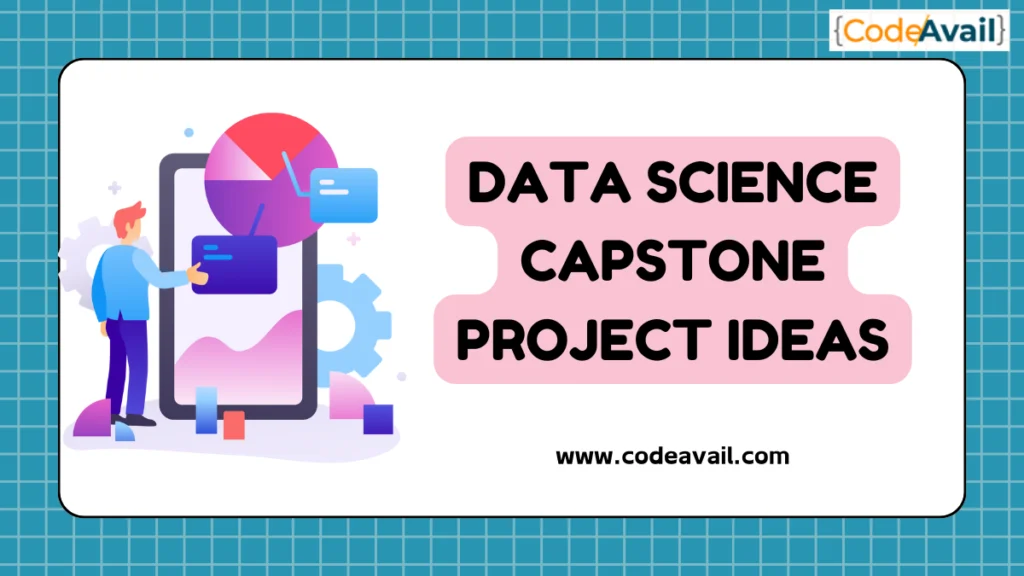
Data science, encompassing the analysis and interpretation of data, stands as a cornerstone of modern innovation.
Capstone projects in data science education play a pivotal role, offering students hands-on experience to apply theoretical concepts in practical settings.
These projects serve as a culmination of their learning journey, providing invaluable opportunities for skill development and problem-solving.
Our blog is dedicated to guiding prospective students through the selection process of data science capstone project ideas. It offers curated ideas and insights to help them embark on a fulfilling educational experience.
Join us as we navigate the dynamic world of data science, empowering students to thrive in this exciting field.
Data Science Capstone Project: A Comprehensive Overview
Table of Contents
Data science capstone projects are an essential component of data science education, providing students with the opportunity to apply their knowledge and skills to real-world problems.
Capstone projects challenge students to acquire and analyze data to solve real-world problems. These projects are designed to test students’ skills in data visualization, probability, inference and modeling, data wrangling, data organization, regression, and machine learning.
In addition, capstone projects are conducted with industry, government, and academic partners, and most projects are sponsored by an organization.
The projects are drawn from real-world problems, and students work in teams consisting of two to four students and a faculty advisor.
However, the goal of the capstone project is to create a usable/public data product that can be used to show students’ skills to potential employers.
Best Data Science Capstone Project Ideas – According to Skill Level
Data science capstone projects are a great way to showcase your skills and apply what you’ve learned in a real-world context. Here are some project ideas categorized by skill level:
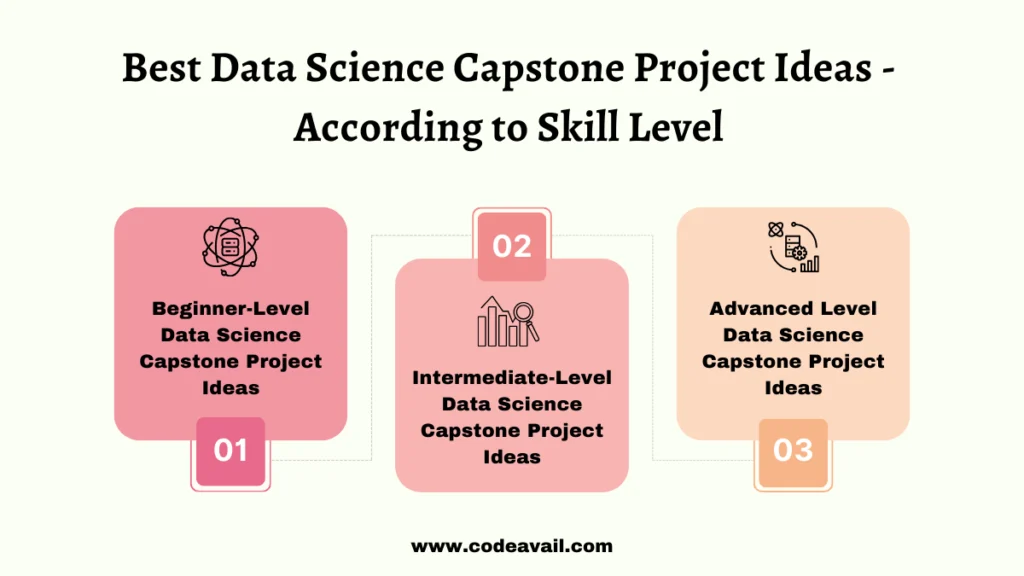
Beginner-Level Data Science Capstone Project Ideas
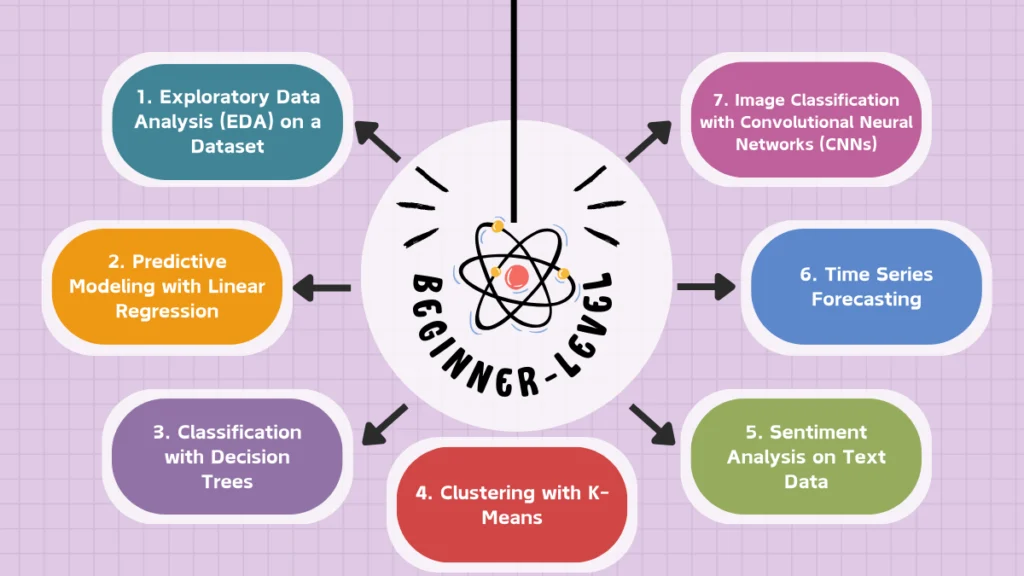
1. Exploratory Data Analysis (EDA) on a Dataset
Start by analyzing a dataset of your choice and exploring its characteristics, trends, and relationships. Practice using basic statistical techniques and visualization tools to gain insights and present your findings clearly and understandably.
2. Predictive Modeling with Linear Regression
Build a simple linear regression model to predict a target variable based on one or more input features. Learn about model evaluation techniques such as mean squared error and R-squared, and interpret the results to make meaningful predictions.
3. Classification with Decision Trees
Use decision tree algorithms to classify data into distinct categories. Learn how to preprocess data, train a decision tree model, and evaluate its performance using metrics like accuracy, precision, and recall. Apply your model to practical scenarios like predicting customer churn or classifying spam emails.
4. Clustering with K-Means
Explore unsupervised learning by applying the K-Means algorithm to group similar data points together. Practice feature scaling and model evaluation to identify meaningful clusters within your dataset. Apply your clustering model to segment customers or analyze patterns in market data.
5. Sentiment Analysis on Text Data
Dive into natural language processing (NLP) by analyzing text data to determine sentiment polarity (positive, negative, or neutral).
Learn about tokenization, text preprocessing, and sentiment analysis techniques using libraries like NLTK or spaCy. Apply your skills to analyze product reviews or social media comments.
6. Time Series Forecasting
Predict future trends or values based on historical time series data. Learn about time series decomposition, trend analysis, and seasonal patterns using methods like ARIMA or exponential smoothing. Apply your forecasting skills to predict stock prices, weather patterns, or sales trends.
7. Image Classification with Convolutional Neural Networks (CNNs)
Explore deep learning concepts by building a basic CNN model to classify images into different categories.
Learn about convolutional layers, pooling, and fully connected layers, and experiment with different architectures to improve model performance. Apply your CNN model to tasks like recognizing handwritten digits or classifying images of animals.
Intermediate-Level Data Science Capstone Project Ideas
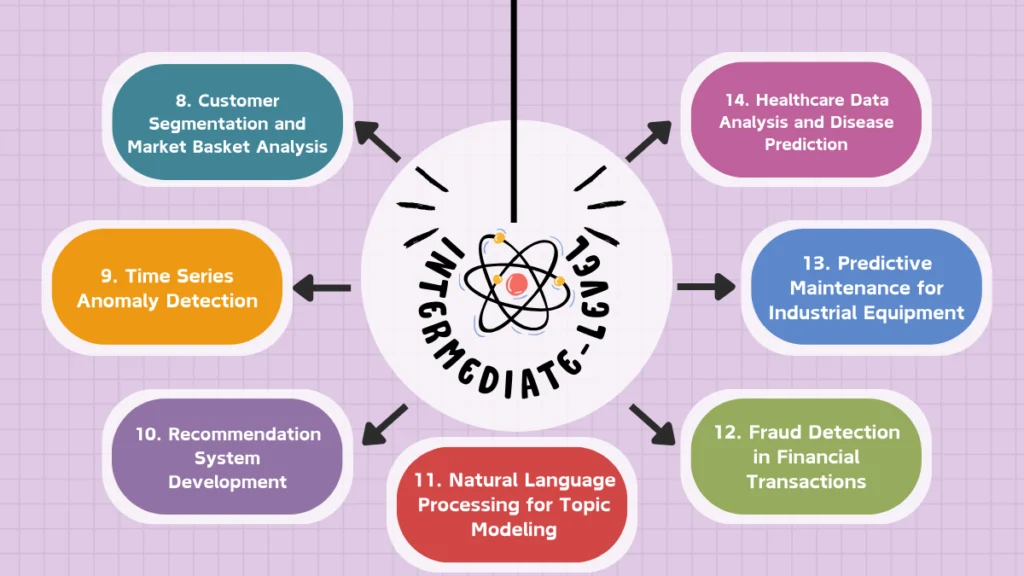
8. Customer Segmentation and Market Basket Analysis
Utilize advanced clustering techniques to segment customers based on their purchasing behavior. Conduct market basket analysis to identify frequent item associations and recommend personalized product suggestions.
Implement techniques like the Apriori algorithm or association rules mining to uncover valuable insights for targeted marketing strategies.
9. Time Series Anomaly Detection
Apply anomaly detection algorithms to identify unusual patterns or outliers in time series data. Utilize techniques such as moving average, Z-score, or autoencoders to detect anomalies in various domains, including finance, IoT sensors, or network traffic.
Develop robust anomaly detection models to enhance data security and predictive maintenance.
10. Recommendation System Development
Build a recommendation engine to suggest personalized items or content to users based on their preferences and behavior. Implement collaborative filtering, content-based filtering, or hybrid recommendation approaches to improve user engagement and satisfaction.
Evaluate the performance of your recommendation system using metrics like precision, recall, and mean average precision.
11. Natural Language Processing for Topic Modeling
Dive deeper into NLP by exploring topic modeling techniques to extract meaningful topics from text data.
Implement algorithms like Latent Dirichlet Allocation (LDA) or Non-Negative Matrix Factorization (NMF) to identify hidden themes or subjects within large text corpora. Apply topic modeling to analyze customer feedback, news articles, or academic papers.
12. Fraud Detection in Financial Transactions
Develop a fraud detection system using machine learning algorithms to identify suspicious activities in financial transactions. Utilize supervised learning techniques such as logistic regression, random forests, or gradient boosting to classify transactions as fraudulent or legitimate.
Employ feature engineering and model evaluation to improve fraud detection accuracy and minimize false positives.
13. Predictive Maintenance for Industrial Equipment
Implement predictive maintenance techniques to anticipate equipment failures and prevent costly downtime.
Analyze sensor data from machinery using machine learning algorithms like support vector machines or recurrent neural networks to predict when maintenance is required. Optimize maintenance schedules to minimize downtime and maximize operational efficiency.
14. Healthcare Data Analysis and Disease Prediction
Utilize healthcare datasets to analyze patient demographics, medical history, and diagnostic tests to predict the likelihood of disease occurrence or progression.
Apply machine learning algorithms such as logistic regression, decision trees, or support vector machines to develop predictive models for diseases like diabetes, cancer, or heart disease. Evaluate model performance using metrics like sensitivity, specificity, and area under the ROC curve.
Advanced Level Data Science Capstone Project Ideas
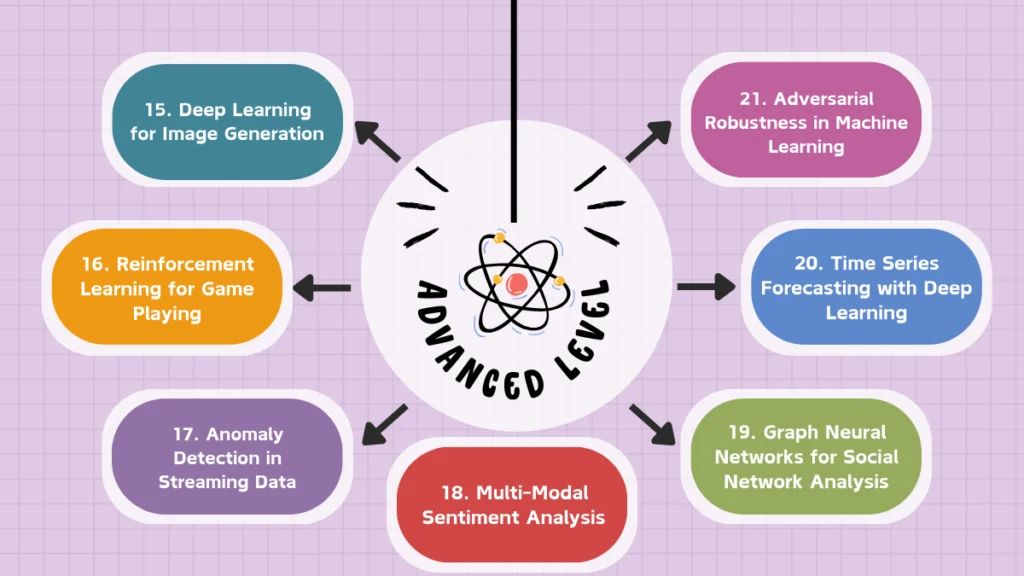
15. Deep Learning for Image Generation
Explore generative adversarial networks (GANs) or variational autoencoders (VAEs) to generate realistic images from scratch. Experiment with architectures like DCGAN or StyleGAN to create high-resolution images of faces, landscapes, or artwork.
Evaluate image quality and diversity using perceptual metrics and human judgment.
16. Reinforcement Learning for Game Playing
Implement reinforcement learning algorithms like deep Q-learning or policy gradients to train agents to play complex games like Atari or board games.
Experiment with exploration-exploitation strategies and reward-shaping techniques to improve agent performance and achieve superhuman levels of gameplay.
17. Anomaly Detection in Streaming Data
Develop real-time anomaly detection systems to identify abnormal behavior in streaming data streams such as network traffic, sensor readings, or financial transactions.
Utilize online learning algorithms like streaming k-means or Isolation Forest to detect anomalies and trigger timely alerts for intervention.
18. Multi-Modal Sentiment Analysis
Extend sentiment analysis to incorporate multiple modalities such as text, images, and audio to capture rich emotional expressions.
However, utilize deep learning architectures like multimodal transformers or fusion models to analyze sentiment across different modalities and improve understanding of complex human emotions.
19. Graph Neural Networks for Social Network Analysis
Apply graph neural networks (GNNs) to model and analyze complex relational data in social networks. Use techniques like graph convolutional networks (GCNs) or graph attention networks (GATs) to learn node embeddings and predict node properties such as community detection or influential users.
20. Time Series Forecasting with Deep Learning
Explore advanced deep learning architectures like long short-term memory (LSTM) networks or transformer-based models for time series forecasting.
Utilize attention mechanisms and multi-horizon forecasting to capture long-term dependencies and improve prediction accuracy in dynamic and volatile environments.
21. Adversarial Robustness in Machine Learning
Investigate techniques to improve the robustness of machine learning models against adversarial attacks.
Explore methods like adversarial training, defensive distillation, or certified robustness to mitigate vulnerabilities and ensure model reliability in adversarial perturbations, particularly in critical applications like autonomous vehicles or healthcare.
These project ideas cater to various skill levels in data science, ranging from beginners to experts. Choose a project that aligns with your interests and skill level, and don’t hesitate to experiment and learn along the way!
Factors to Consider When Choosing a Data Science Capstone Project
Choosing the right data science capstone project is crucial for your learning experience and effectively showcasing your skills. Here are some factors to consider when selecting a data science capstone project:
Personal Interest
Select a project that aligns with your passions and career goals to stay motivated and engaged throughout the process.
Data Availability
Ensure access to relevant and sufficient data to complete the project and draw meaningful insights effectively.
Complexity Level
Consider your current skill level and choose a project that challenges you without overwhelming you, allowing for growth and learning.
Real-World Impact
Aim for projects with practical applications or societal relevance to showcase your ability to solve tangible problems.
Resource Requirements
Evaluate the availability of resources such as time, computing power, and software tools needed to execute the project successfully.
Mentorship and Support
Seek projects with opportunities for guidance and feedback from mentors or peers to enhance your learning experience.
Novelty and Innovation
Explore projects that push boundaries and explore new techniques or approaches to demonstrate creativity and originality in your work.

Tips for Successfully Completing a Data Science Capstone Project
Successfully completing a data science capstone project requires careful planning, effective execution, and strong communication skills. Here are some tips to help you navigate through the process:
- Plan and Prioritize: Break down the project into manageable tasks and create a timeline to stay organized and focused.
- Understand the Problem: Clearly define the project objectives, requirements, and expected outcomes before analyzing.
- Explore and Experiment: Experiment with different methodologies, algorithms, and techniques to find the most suitable approach.
- Document and Iterate: Document your process, results, and insights thoroughly, and iterate on your analyses based on feedback and new findings.
- Collaborate and Seek Feedback: Collaborate with peers, mentors, and stakeholders, actively seeking feedback to improve your work and decision-making.
- Practice Communication: Communicate your findings effectively through clear visualizations, reports, and presentations tailored to your audience’s understanding.
- Reflect and Learn: Reflect on your challenges, successes, and lessons learned throughout the project to inform your future endeavors and continuous improvement.
By following these tips, you can successfully navigate the data science capstone project and demonstrate your skills and expertise in the field.
Wrapping Up
In wrapping up, data science capstone project ideas are invaluable in bridging the gap between theory and practice, offering students a chance to apply their knowledge in real-world scenarios.
They are a cornerstone of data science education, fostering critical thinking, problem-solving, and practical skills development.
As you embark on your journey, don’t hesitate to explore diverse and challenging project ideas. Embrace the opportunity to push boundaries, innovate, and make meaningful contributions to the field.
Share your insights, challenges, and successes with others, and invite fellow enthusiasts to exchange ideas and experiences.
1. What is the purpose of a data science capstone project?
A data science capstone project serves as a culmination of a student’s learning experience, allowing them to apply their knowledge and skills to solve real-world problems in the field of data science. It provides hands-on experience and showcases their ability to analyze data, derive insights, and communicate findings effectively.
2. What are some examples of data science capstone projects?
Data science capstone projects can cover a wide range of topics and domains, including predictive modeling, natural language processing, image classification, recommendation systems, and more. Examples may include analyzing customer behavior, predicting stock prices, sentiment analysis on social media data, or detecting anomalies in financial transactions.
3. How long does it typically take to complete a data science capstone project?
The duration of a data science capstone project can vary depending on factors such as project complexity, available resources, and individual pace. Generally, it may take several weeks to several months to complete a project, including tasks such as data collection, preprocessing, analysis, modeling, and presentation of findings.
Related Posts

Science Fair Project Ideas For 6th Graders
When it comes to Science Fair Project Ideas For 6th Graders, the possibilities are endless! These projects not only help students develop essential skills, such…

Java Project Ideas for Beginners
Java is one of the most popular programming languages. It is used for many applications, from laptops to data centers, gaming consoles, scientific supercomputers, and…
Navigation Menu
Search code, repositories, users, issues, pull requests..., provide feedback.
We read every piece of feedback, and take your input very seriously.
Saved searches
Use saved searches to filter your results more quickly.
To see all available qualifiers, see our documentation .
capstone-project
Here are 761 public repositories matching this topic..., mathworks / matlab-simulink-challenge-project-hub.
This MATLAB and Simulink Challenge Project Hub contains a list of research and design project ideas. These projects will help you gain practical experience and insight into technology trends and industry directions.
- Updated Apr 11, 2024
navassherif98 / IBM_Data_Science_Professional_Certification
This repository contains all the resources and solution to quizzes given and asked in IBM Data Science Professional Certification.
- Updated Jan 14, 2024
- Jupyter Notebook
Vatshayan / Live-Chatbot-for-Final-Year-Project
Chatbot system for Final Year Project. Chatbot made in Python using Natural Language Toolkit especially Machine Learning. Easy to Understand and Implement.
- Updated Aug 12, 2022
Vatshayan / Fake-News-Detection-Project
Final Year Fake News Detection using Machine learning Project with Report, PPT, Code, Research Paper, Documents and Video Explanation.
- Updated Dec 21, 2022
sahidul-shaikh / credit-card-fraud-detection
Machine learning model for Credit Card fraud detection
- Updated Jan 10, 2021
Akash-goyal-github / Inventory-Management-System
⭐Inventory Management System⭐demonstrates the CRUD (Create, Read, Update and Delete) operations which is done using Tech Stack ⭐Angular, Spring Boot and Mysql. 💯 💥. On the landing page of the application displaying all the records where user can insert/create the Product, update the Product, delete the Product. 💯 💥
- Updated Dec 15, 2023
creme332 / my-odin-projects
A compilation of all my programming projects for The Odin Project web development course.
- Updated May 7, 2024
nikoescobal / COFFEECON2020
This project is a fully responsive site that fulfills Microverse’s HTML/CSS Capstone Requirements
Projects-Developer / Google-Stock-Price-Prediction-by-Deep-Learning
Top Class Stock Price Prediction Project through Machine Learning Algorithms for Google. Easy Understanding and Implementation. B.tech Final Year College Project.
- Updated Dec 20, 2021
aboerzel / German_License_Plate_Recognition
Android camera app for automatic recognition of German license plates using TensorFlow / TensorFlow Lite 2.4.1
- Updated Jan 7, 2023
limchiahooi / Coursera_Capstone
Capstone project for IBM Data Science Professional Certificate on Coursera.
- Updated Jan 31, 2019
Vatshayan / Final-year-Project-steganography
Steganography is the technique of hiding secret data within an ordinary, non-secret, file or message in order to avoid detection; the secret data is then extracted at its destination.
- Updated Aug 14, 2022
Vatshayan / Network-Intrusion-Detection-Project
Network Intrusion Detection System Project using Machine Learning with code and Documents
Kingjosh007 / capstone2-countries-facts
This is the repo for the second capstone project in our Microverse journey. It is a group project created by @Fikerte-T and I. We build it around a countries API.
- Updated Jan 17, 2022
juancoob / Vegginner
App to change our consumption habits, fight against climate change and take part in relieving the world in hunger in our everyday life.
- Updated Oct 7, 2020
lk-learner / IBM-Data-Analyst-Professional-Certificate
IBM DATA ANALYST PROFESSIONAL CERTIFICATE
- Updated Apr 10, 2023
alexismenest / meta-front-end-developer-capstone
My capstone project for the Meta Front-End Developer Professional Certificate
- Updated Dec 1, 2023
VelzckC0D3 / Velzck_Festival
In this capstone project, I demonstrated how to manage the DOM properly using Vanilla JavaScript. I was able to develop a dynamic and responsive website that showcases my improved skills, while also incorporating correct GitFlow usage and Linters for better code quality.
- Updated Aug 19, 2023
sanjitva / Predicting-Football-Player-Transfer-Values
Flatiron School Capstone project. Trying to find out how well players' on-field performance metrics can be used to predict their transfer values.
- Updated Oct 13, 2021
Improve this page
Add a description, image, and links to the capstone-project topic page so that developers can more easily learn about it.
Curate this topic
Add this topic to your repo
To associate your repository with the capstone-project topic, visit your repo's landing page and select "manage topics."
Data Science Master’s Students Tackle Diverse, Real-World Challenges in Capstone Projects
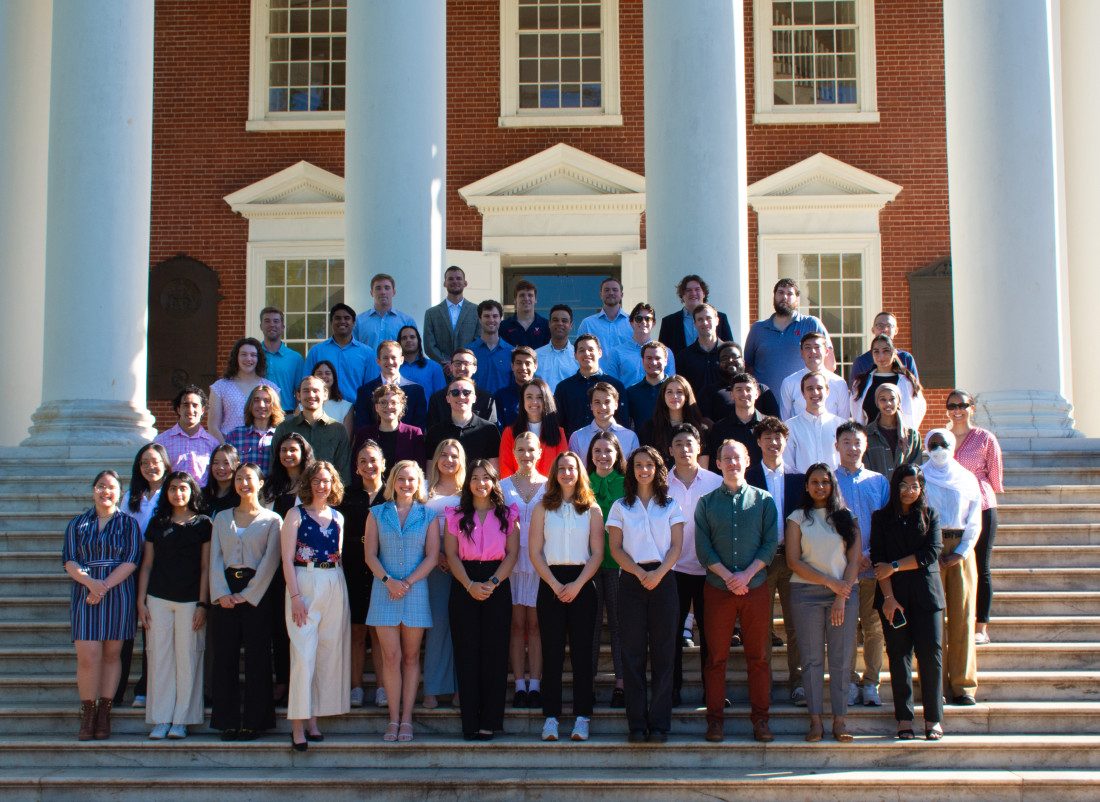
Human trafficking, illegal fishing, small business contracts — these are all issues that, at first glance, seemingly have little in common.
Yet, for students in the University of Virginia’s data science residential master’s program , these disparate subjects have one critical common denominator: they could all be better understood through the application of data science methods.
Fifteen groups of graduate students at the School of Data Science recently presented the findings of their capstone projects before a sizable crowd of faculty, staff, and fellow students at the Graduate hotel in Charlottesville.
Capstone projects have long been a cornerstone of the data science master’s program. In them, students work in groups with a faculty mentor as well as an outside sponsor to tackle a real-world problem.
It’s an opportunity for students to collaborate with their classmates and apply what they are learning from faculty toward addressing a real issue that their sponsor is dealing with — experiences that often leave lasting impressions.
“When we talk to alumni years later, they all say that the two things that they remember most about the program are the capstone experience and also a cohort experience,” said Phil Bourne , founding dean of the School of Data Science, in opening remarks.
The projects offered students the chance to learn about new subjects and methods as well as develop skills that could prove vital as they begin their careers.
“While you’ve done many projects, this is the first time that it was a very large project that you had to break it up and project manage it,” Adam Tashman , an associate professor of data science and capstone program director, told the students.
He added that perhaps the most important lesson students will take from the experience is “how to deliver for a customer.”
For more than four hours, with a break for lunch, groups of students laid out their findings in brief presentations followed by questions from the audience.
In one, which focused on predicting which federal agencies small businesses could match with to secure contracts, David Diaz , whose father owns a small business in California, described the personal nature of the group’s work.
“I’ve seen this firsthand; I still see it with my dad now. There are a lot of long hours. It isn’t really a 9 to 5 job — it’s a 24/7 job,” Diaz said, describing the continual process that small business owners face in gathering information to try to secure bids while ensuring business operations run efficiently.
“So, the goal of this project is to hopefully reduce that research time in reaching the federal contracting market and, hopefully, allow businesses to have a finer scope into what they’re looking for,” he added.
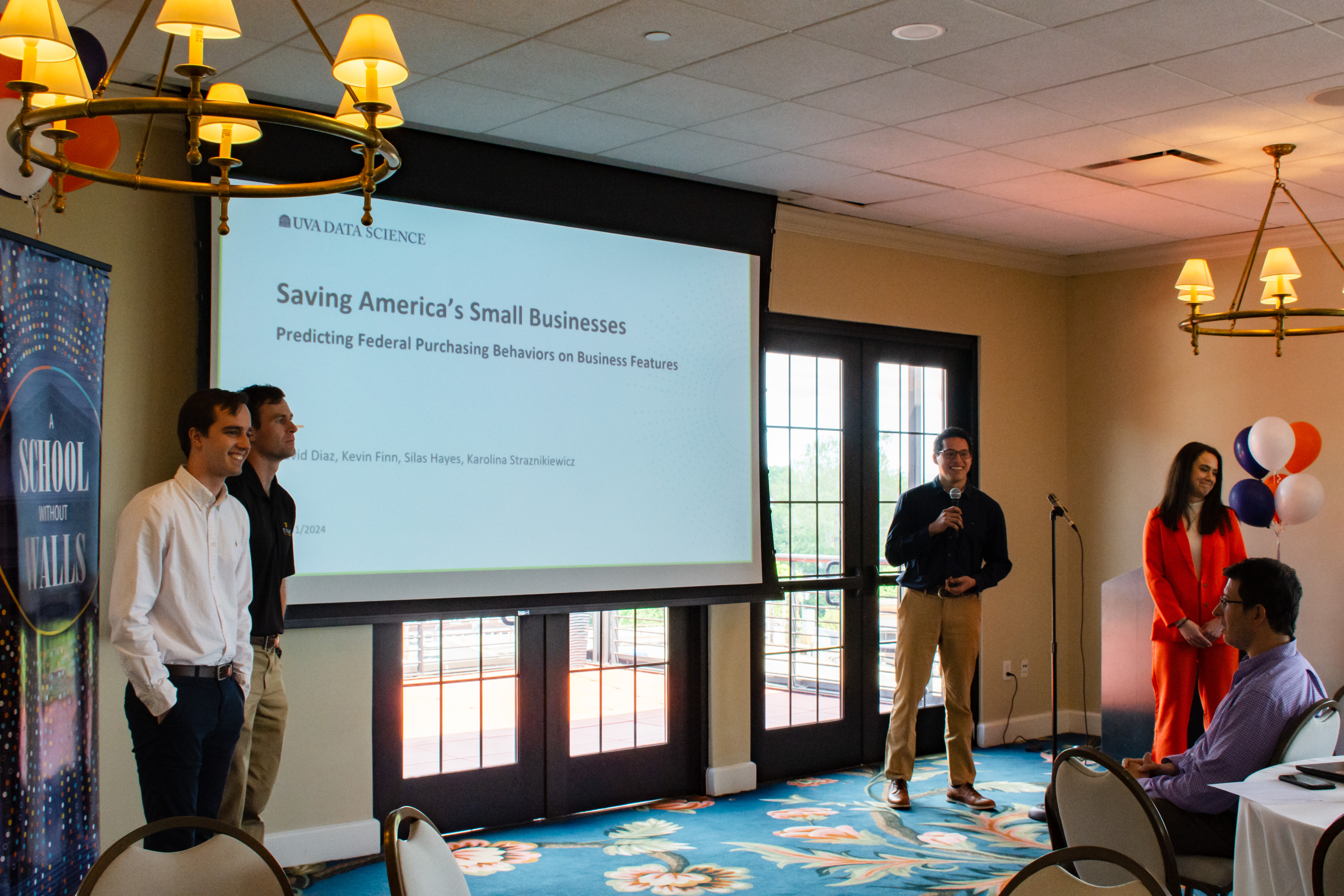
Another group laid out their work on illegal fishing, discussing the complexity of this global issue and the vast problems it creates. They also highlighted a key point that any data scientist must confront: how to classify the data they had.
“Kind of like an indie album, our data set is unlabeled,” joked Samuel Brown, who explained how he and his group created labels to differentiate between illegal and illegal fishing.
The group discussed how their project demonstrated how machine learning could be used to help predict illegal fishing, information that could, potentially, reduce its prevalence.
Like any complex challenge, completing a capstone project can be stressful. And in those difficult times, sources of wisdom are sometimes found in unexpected places.
Sunidhi Goyal , who works as a tennis instructor for UVA Recreation, recounted how one of her six-year-old students asked her one day what was bothering her.
Goyal, part of a group that worked with LMI on empowering their enterprise architecture team, said she wasn’t sure how she could explain the complexities of their project to a young child.
But she tried, describing, in simple terms, how she and her collaborators needed to find a way to allow enterprise architects to sort through a large number of documents and keep just the relevant ones — the “good” documents, she called them.
“She was like, ‘Oh, what if the good could be a magnet, and you could keep it together and let go of the bad,” Goyal said the student responded.
“This is exactly what we ended up doing,” Goyal said, explaining how her team used a method called principal component analysis to retain only the most relevant documents, an approach that helped lead them to their solution.

As the day wound down, audience members voted on awards, and Tashman praised the students for the effort, passion, and purpose they exhibited in taking on the challenges presented by their sponsors.
“These are all important things that our sponsors need help with, and you all took ownership of that. I think you took it to heart and really put your heart and soul into it,” he said.
And while the completion of their capstone projects signaled an end to their time as master’s students at the School of Data Science, it also marked the beginning of a much longer journey to come.
“Let this be the first of many real-world problems that you face and that you tackle,” Tashman said.
Awards, as voted on by the audience
Most Innovative Analytical Solution : “Optimizing the ALMA Research Proposal Process with Machine Learning”
Group members: Brendan Puglisi, Arnav Boppudi, Kaleigh O’Hara, Noah McIntire, Ryan Lipps
Most Compelling Data Visualization : “Detecting Illegal Fishing with Automatic Identification Systems and Machine Learning”
Group members: Samuel Brown, Danielle Katz, Dana Korotovskikh, Stephen Kullman
Most Engaging Data Story : “Predicting Winter California Precipitation with Convolutional Neural Networks”
Group members: Anthony Chiado, Kristian Olsson, Luke Rohlwing, Michael Vaden
Most Impactful Ethical Engagement : “Detecting Human Trafficking
Group members: Jacqui Unciano, Grace Zhang, Tatev Gomtsyan, Serene Lu

‘A Big Moment’: Online Data Science Master’s Students Present Captone Projects
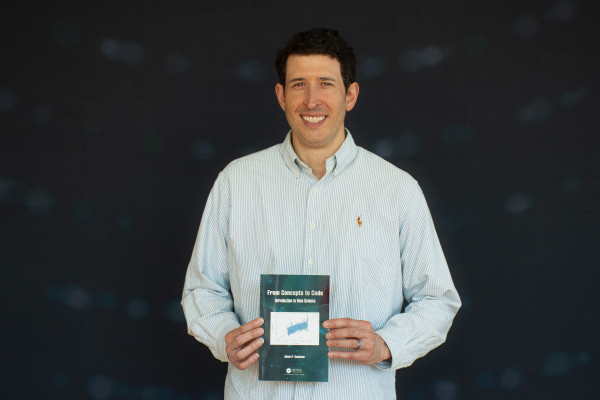
Professor Promotes Data Literacy With New Book
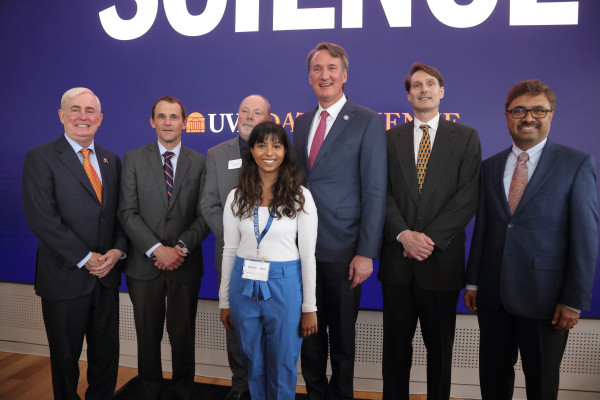
News Roundup: School of Data Science Celebrates Grand Opening of New Home
Get the latest news.
Subscribe to receive updates from the School of Data Science.
- Prospective Student
- School of Data Science Alumnus
- UVA Affiliate
- Industry Member
- The Vice Chancellor and Dean
- Facts and Figures
- Our Departments
- Zachry Engineering Education Complex
- Advising and Support
- Degree Programs
- Engineering Academies
- Online Degrees by Department
- Online Courses
- Engineering Global Programs
- Admissions and Aid
- Undergraduate Admissions
- Graduate Admissions
- Transfer Students
- Entry to a Major
- Explore Engineering Career Paths
- Visit With Us
- Student Life
- Find Your Community
- Get Creative
- Interact with Industry
- Solve Problems
- SuSu and Mark A. Fischer '72 Engineering Design Center
- Meloy Engineering Innovation and Entrepreneurship Program
- Undergraduate Research
- Autonomy and Robotics
- Education and Training Research
- Energy Systems and Services Research
- Health Care Research
- Infrastructure Research
- Materials and Manufacturing Research
- National Security and Safety Research
- Space Engineering
- Partner With Us
- PK-12 and Educators
- Researchers
- Reach Our Divisions
Engineering Project Showcase Highlights Senior Capstone Design Projects
May 6, 2024 By Danielle Sullivan
- Campus Community
- Current Students

The 12th annual Engineering Project Showcase at Texas A&M University included over 300 teams of 1,400 students presenting their senior capstone design projects and competing for top prizes. The event, which was hosted at the Zachry Engineering Education Complex, brought together 170 industry judges to observe a year's worth of dedicated work and innovation.
The showcase highlighted the collaborative efforts between academia and industry, with students addressing real-world challenges presented by academic departments or industry sponsors. These challenges formed the basis for projects aimed at tackling pressing issues across various sectors. Magdalini Lagoudas, executive director of Industry/Nonprofit Partnerships, stressed the crucial role of capstone design projects in bridging theoretical knowledge with practical application.
“The Engineering Project Showcase allows us to celebrate the accomplishments of our capstone student teams and the incredible value they generate for their sponsors,” said Lagoudas. “It is also a great way for industry to see examples of successful academic partnerships with the College of Engineering.”
Overall, the event's goals are to celebrate students' innovative solutions to real-world problems, foster engagement with industry partners and collaboration within the teams themselves, and promote STEM awareness among prospective students and educators.

"The students are very well-prepared here at the College of Engineering, and they are very impressive,” said Lynda Estes '87, an employee in the structures group at NASA. “I do a lot of mentoring of co-ops where I work and what I see here is a lot of that work getting done ahead of time, specifically with getting to work with others from different backgrounds that may not be similar to yours, but then figuring out how to divide up the work, get it done and put it all back together to create a final project. I think a skill like that is very helpful to all these students."
Beyond celebrating academic achievements and collaboration, the showcase also facilitated invaluable networking opportunities between students and industry professionals.
"Andersen Windows & Doors looks for students who are flexible, eager to learn, and want to be hands-on,” said Felicia Nguyen, a representative from Andersen Windows & Doors, a platinum sponsor. “Engineering Project Showcase allows the students to show what they have learned and what skills they can bring to our corporation. We sponsor events like this because we want students to know what Andersen does and what we bring to the table. We want to be able to give them opportunities when they get out of school to bring their talent to work with us full-time."
A highlight of the showcase was the announcement of the Overall Showcase Capstone Design Awards. Teams from diverse majors, ranging from aerospace engineering to biological and agricultural engineering, competed for top prizes. With 18 different award categories, the event’s prize pool totaled over $20,000.
Two teams tied for the Overall Showcase Capstone Design first-place award. The project Autonomous and Remote Control Operating Light (ARCOL), sponsored by Texas A&M University’s J. Mike Walker ’66 Department of Mechanical Engineering, addresses the challenges faced in operating rooms where frequent adjustments to surgical lighting are needed. The ARCOL system offers autonomous and remote-control capabilities to minimize disruptions during surgeries, such as shadows and obstructions. By providing a cheaper, safer, and more efficient operating environment, it aims to enhance patient care.
Sponsored by Laken Grimes and Dessert Holdings, Production Line Modeling geared their project towards streamlining the management of a production line. Inefficiencies and bottlenecks often happen with fluctuating product sequences, equipment setups, crew compositions, and processing durations. The primary objective of the project is to craft a simulation tool capable of foreseeing process challenges, furnishing feedback on schedule viability and ultimately heightening operational effectiveness.

The annual Engineering Project Showcase offers a platform for students to apply their skills in innovation and collaboration taught by Texas A&M Engineering. Join us at the next showcase to witness future projects on April 25, 2025.
The 2024 Engineering Project Showcase was sponsored by platinum sponsors, Andersen Windows & Doors and Samsung; gold sponsors, Bray Inc. and Caterpillar; and silver sponsors, Baker Hughes, Endeavor Energy Resources and H4 Architects + Engineers.
The top teams from each award category are listed below.
Engineering Project Showcase 2024 Winners:
Overall showcase capstone award.
First place - Tie ($2,000) Team: Autonomous and Remote Control Operating Light (ARCOL)
First place - Tie ($2,000) Team: Production Line Modeling
Third place ($1,000), sponsored by Samsung Team: OGRE Skin Test Rig
Biological and Agricultural Engineering Award
First place - Tie ($500) Team: Design and Implementation of Water Distribution and Filtration System in Remote Guatemala
First place - Tie ($500) Team: SCTHS Rainwater Harvesting
Third place ($250) Team : Kubota Tractor Lead/Lag Ratio Tire Testing
Biomedical Engineering Awards
First place - Tie ($750), sponsored by Bray International Inc. Team: Improved Vesicoamniotic Shunt for Treatment of Fetal LUTO
Second place - Tie ($750) Team: Combined Continuous Glucose Monitor and Infusion Set
Second place - Tie ($750) Teams : Fetal Stabilization for Fetoscopic Surgery
Computer Science and Engineering Awards
First place - Tie ($1,000), sponsored by Andersen Windows & Doors Team : FlashMacros: Automating Calorie and Macronutrient Tracking
First place - Tie ($1,000), sponsored by Andersen Windows & Doors Team : Promenade
Second place - Tie ($750) Team : BoomBoards
Second place - Tie ($750) Team : SCRAPS
Electrical and Computer Engineering Awards
First place ($1,000), sponsored by Samsung Team: Raytheon Drone Competition
Second place ($750) Team: RFID PC Passkey System
Third place ($500) Team: Radiation Resilient Logic Circuits
Industrial and Systems Engineering Awards
First place ($1,000), sponsored by Caterpillar Inc. Team: Calibration Lab
Second place ($750) Team: Applied Materials - Detrash/Marry-Up Area Improvement
Third place ($500) Team: CHRISTUS Health Warehouse Optimization
Material Science and Engineering Awards
First place ($500) Team: Sealing the Deal for Hydrogen Fuel: Characterizing Elastomeric Sealing Materials for High Pressure Hydrogen Environments
Second place ($350) Team: Metal Turnings Recycling Through ECAE
Third place ($250) Team : Design and Evaluation of Novel Recycling Methods for Coated Polymeric Automotive Components
Mechanical Engineering Awards
First place ($1,000), sponsored by Andersen Windows & Doors Team: Continuous Cement Mixing Head Redesign
Second place - Tie ($750) Team: Parking Alert Service Project
Second place - Tie ($750) Team: Pipeline Displacement Detection Unit
Mechanical Manufacturing Engineering Technology Award
First place ($500)
Team: The Destabilizer
Second place ($350)
Team: Team GDMAN - Automated Camera System
Third place ($250)
Team: Fluid Powered Vehicle
Energy Sector Award
Prize Amount: $250 Team: Predicting & Optimizing the Power Performance of Dye Sensitized Solar Cells Using Machine Learning Techniques
Health Sector Award
Prize Amount: $250 Team: Improved Vesicoamniotic Shunt for Treatment of Fetal LUTO
Infrastructure Sector Award
Prize Amount: $250 Team: Alternate Route Study
Manufacturing Sector Award
Prize Amount: $250 Team: Team Metal Turnings Recycling Through ECAE
National Security Sector Award
Prize Amount: $250 Team: Crypto-Analysis Resistant Digital Key FOB
Large Capstone Team Award
Prize Amount: $1,000 Team: LHIVA: Long-Range Hybrid eVTOL Integrated Assembly
Non-capstone Team Award
Prize Amount: $1,000 Team: RASC-AL 2024: Large-Scale Lunar Crater Prospector
- Facebook Facebook
- Twitter Twitter
- LinkedIn LinkedIn
- Email Email
- Print Print
Six seniors recognized with Dean’s Awards for outstanding capstone projects
Topics include a method to detect earthquake victims and an image-to-text application for the visually impaired.
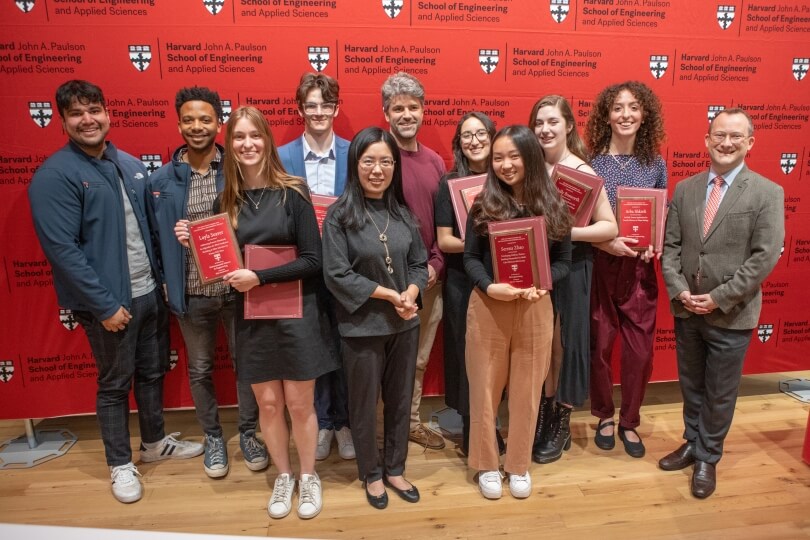
Six SEAS students have been recognized with Dean’s Award for Outstanding Engineering Projects (Eliza Grinnell/SEAS)
Six students from the Harvard John A. Paulson School of Engineering and Applied Sciences (SEAS) were recognized with the Dean’s Award for Outstanding Engineering Projects at the recent SEAS Design and Project Fair at the Science and Engineering Complex. Recipients participated in ES100, a year-long capstone course for seniors in the SB engineering program, where each student develops a project to address a real-world engineering problem. The award comes with a prize of $500.
“SEAS students make things that may be really cool, quirky, or fun,” said SEAS Dean David Parkes. “And just as often, their work will help solve a real-world problem and have a significant impact on people’s lives. During ES100, a year-long capstone course for seniors in the SB engineering program, students tackle specific problems. They develop technical specs, design solutions, test their ideas using quantitative analysis and simulations, prototype, and build.”
For the 2023-24 academic year, 42 students completed ES100 projects. Five projects, including one two-student team project, were selected for the award. The award-winning projects covered a broad range of topics, including a remote sensor network for detecting earthquake victims trapped under rubble, an image-to-text application for the visually impaired, a quadcopter drone with enhanced maneuverability, and tool for determining potential water contaminants and suggested filtration solutions in wells.
Serena Zhao’s bioengineering capstone, “Developing Uniform, Photon-Emitting Nanoprobes for Multi-Color Electron Microscopy,” designed nanoprobes that emit colored light when hit by protons from an electron microscope, allowing for much more detailed imaging at the nanoscale level.
“Electron microscopy (EM) images are black and white,” Zhao said. “There’s no specificity, no color labeling. When it comes to studying complex biological processes, that’s a huge disadvantage. My project was trying to build these nanoprobes that emit color under EM, so we can get an electron image, a colored probe image, and then we can overlay them into a colored, labeled image that still has specificity and high resolution.”
The other four award winners were:
- Arba Shkreli and Molly Bosworth, electrical engineering, for their project, “SeASAR: Sensor Application for Search & Rescue in Urban Settings”
- Yasmine Omri, electrical engineering, for her project, “Towards a Real-Time Image-to-Speech Tool for the Visually Impaired: Efficient Hardware for On-device Image Classification”
- Lachlan McGranahan , mechanical engineering, for his project, “Modeling, Simulation, and Control for a Tilt-Rotor Quadcopter”
- Layla Seaver, environmental science and engineering, for her project, “Addressing Forever Chemicals: An Algorithm for PFAS Prediction Modeling and Filter Selection for Private Well-Users”
“I’m interested in using my engineering background to serve actual human needs,” Omri said. “My project falls into a field that we call ‘tiny machine learning.’ I wanted to find a way to run a very complex system locally, with energy efficiency and performance speed. I tried to consolidate it into a practical, application-based system focused specifically on the visually impaired.”
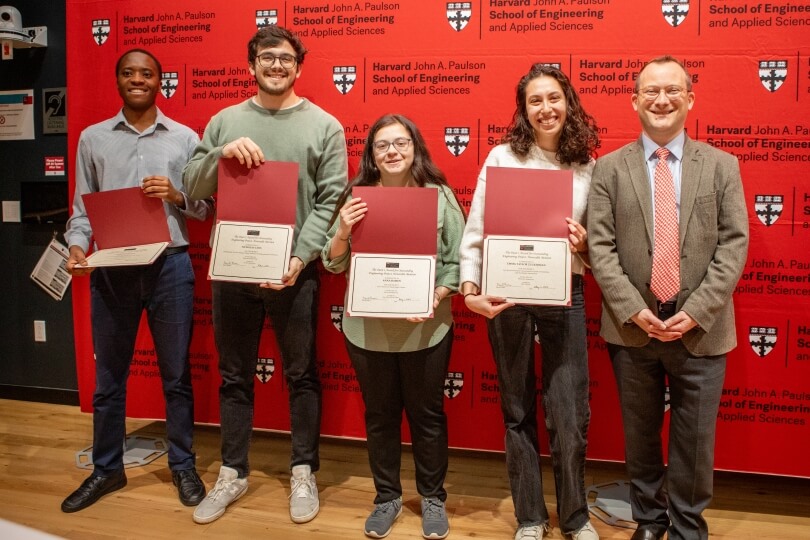
Four SEAS students received Honorable Mention for their senior capstone projects (Eliza Grinnell/SEAS)
Four additional SEAS students received Honorable Mentions for their capstone projects. They are:
- Cherish Jongwe, bioengineering, for his project, “Biofilm-Enhanced Household Water Filtration System for Heavy Metals Removal”
- Nicholas Laws , mechanical engineering, for his project, “Visualization Tool for Chemical Kinetic Pathways in Plasma-Assisted Combustion”
- Anna Ramos, electrical engineering, for her project, “Eye Controls for Quadriplegic Gamers”
- Emma Zuckerman, mechanical engineering, for her project, “Low Reynolds Number Anemometer for Earth’s Stratosphere and the Martian Atmosphere”
Seaver also received a $500 award from the Society of American Military Engineers. A former project lead and co-president of the Harvard chapter of Engineers Without Borders, Seaver has devoted most of her Harvard career to water research and infrastructure development.
“I took Elsie Sunderland’s class on toxicology, which introduced the idea of forever chemicals and contaminants like PFAS,” Seaver said. “When it came time to choose a thesis topic, I thought about the importance of these emerging contaminants for water quality and public health, and how I had the opportunity to work with one of the leading experts in this field through Elsie’s lab. If I could create a tool to make that information from the lab more readily available to users, that’d be the best way I could have an impact with my thesis.”
After she graduates, she’ll be working on water projects at the Boston office of Kleinfelder, an engineering firm.
“One of their most recent developments is looking at PFAS removal technology at the municipal level, which I’m really excited about,” she said.
Topics: Academics , Dean , Awards , Bioengineering , Electrical Engineering , Environmental Science & Engineering , Materials Science & Mechanical Engineering
Cutting-edge science delivered direct to your inbox.
Join the Harvard SEAS mailing list.
Press Contact
Matt Goisman | [email protected]
Related News

Suo elected to American Academy of Arts & Sciences
Materials scientist honored for scientific achievements
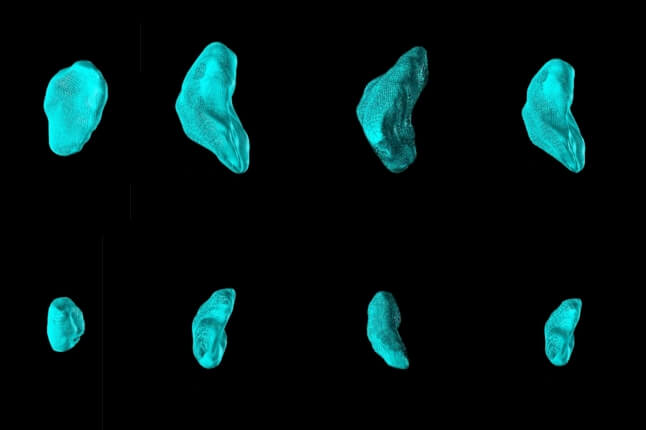
Expanding a lymph node, boosting a vaccine
A biomaterial vaccine enhances and sustains lymph node expansion following vaccination, boosting anti-tumor immunity in an animal model
Bioengineering

EPA underestimates methane emissions from landfills, urban areas
Research highlights importance of high-resolution methane accounting
Climate , Environmental Science & Engineering
DISCOVER THE INNOVATIVE WORK WE ARE DOING ON:
- Air, Food & Water
- Art & Culture
- Cities & Towns
- Climate Change
- Energy & Technology
- Environmental Justice
- Law & Policy
- Nature & Conservation
- Sustainable Business

UCLA seniors model flood vulnerability in Tobago
Slash-and-burn farming and increased surface runoff from urbanization in Tobago have made the small Caribbean island prone to flooding from rivers and streams.
And, as the population of the 116-square-mile island has grown, more residents have settled in parts of the island with high flood risk.
To identify the most vulnerable communities, seven UCLA students developed climate models as part of their capstone project for their environmental science bachelor’s degree . This spring they traveled to Tobago — the smallest of the two islands that make up the nation of Trinidad and Tobago — to collect on-the-ground data to test the accuracy of their maps and meet with collaborators at the University of West Indies (UWI).
The students assessed not just physical characteristics that influence where flooding occurs such as elevation, vegetation cover and soil type, but also socioeconomic factors that affect vulnerability, said Tyler Moy, the advisor of the project. Such factors included income levels, distance to emergency facilities and ability to access information about flooding from existing warning systems,
“The risk map can identify where interventions are needed, but to prove effective, the interventions have to be implemented while considering community needs,” he said.
Before the trip, the team used Geographic Information Systems (computer-based tools used to analyze geospatial data) and satellite images from Sentinel and Landsat (two major satellite programs) to create maps based on physical characteristics like land cover, slope and proximity to rivers in the districts of Roxborough and Castara.
While in Tobago, they collected on the ground-date like elevation and distance to drainage points, which they overlaid with digital elevation models and satellite images to refine their model’s accuracy.
With the help of the UWI students, they also spoke with community members to learn about difficulties they face due to flooding. Based on these conversations, they decided how much to weigh factors like access to flood relief and socioeconomic status in their vulnerability assessment models.
“They’re not just working with a dataset,” said Moy, a Ph.D. student in Environmental Health Sciences. “It’s a real place, real people are there and there are impacts.”
Conversations with community members revealed flooding contributors that the team didn’t even consider, said student Sydney Pearce, who led the satellite data analysis of the project. For instance, the Roxborough community has a high flood risk due to debris from discarded bamboo that clogs drainage.
When conducting work in a different county, it’s important to let locals“take the front seat,” said Pearce, who expects to graduate with an environmental science degree in June. The UWI students knew the local dialect, norms and how to best talk to the community members.
Additionally, the team identified nature-based solutions to flooding, such as l andscape regeneratio n and agricultural techniques that reduce land degradation. They then created a flow chart that connects accurate risk assessments, early warning systems and community engagement — showing how these factors must be tied together for adaptation measures to succeed.
Population growth has outpaced infrastructural upgrades on Tobago, said Marie Inumerable, a student member who leads the Community Engagement portion of the project. Some residents in remote parts of Tobago have only one access road to the rest of the island, so flooding can leave them isolated and without an ability to receive help.
The models can help agencies such as Tobago Emergency Management better assess where flooding interventions are most needed by identifying high risk areas and areas where nature-based solutions may be most effective, she said.
During their free time on the island, both UCLA and UWI students snorkeled, explored beaches, sampled new cuisines and learned about the local culture.
“The UWI students were so hospitable to us,” Inumerable said. “They helped us understand what island life is like and the values of their education system: technical work and research but also a sense of community. This is something we hope to carry on here at UCLA.”
The project was conducted as part of the UCLA Institute of the Environment and Sustainability’s senior practicum, a year-long capstone program that pairs students with nonprofits, private companies and government agencies to solve real-world problems.
The team members are Karina Balekjian, Marie Inumerable, Pippin Jardine, Sky Lane, Mason Lehman, Sydney Pearce, Jorge Reque, and Sallyrose Savage (a graduate student assistant member of the project).
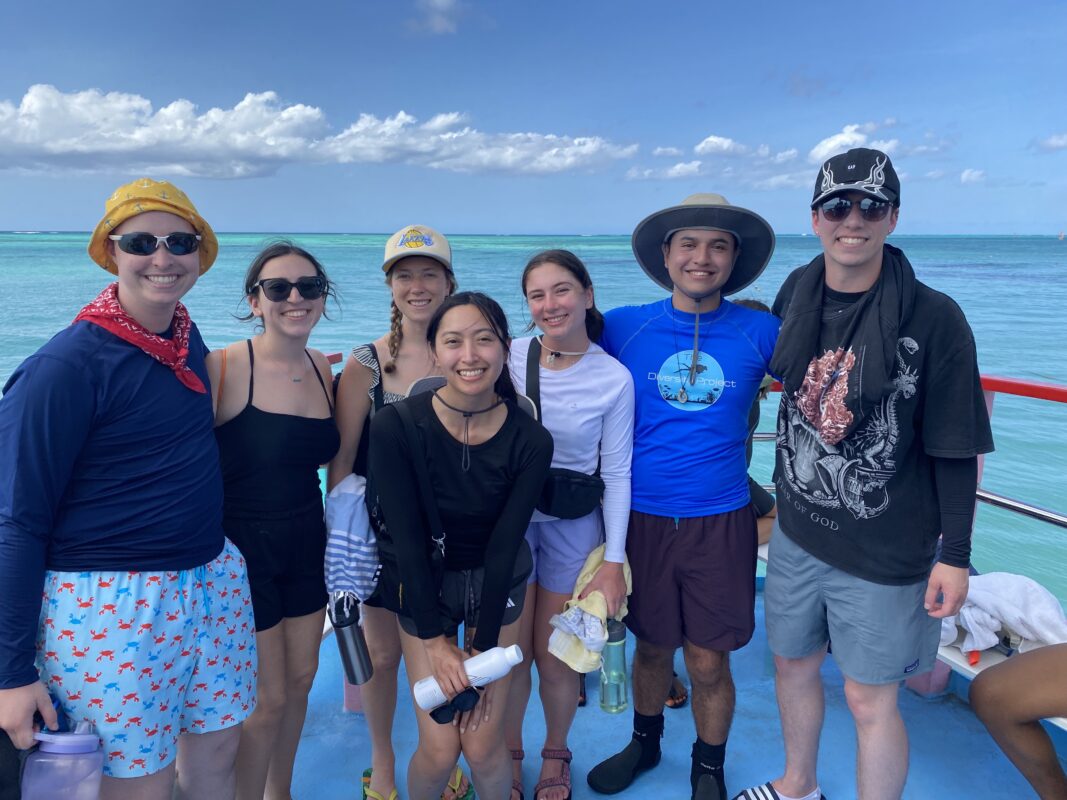
The team members (left to right): Mason Lehman, Karina Balekjian, Sydney Pearce, Marie Inumerable, Pippin Jardine, Jorge Reque, and Sky Lane.
MEET THE AUTHOR

Anna Novoselov
Students present posters for IE431 capstone projects - School of Industrial Engineering - Purdue University

Students present posters for IE431 capstone projects
They showcased their work at the IE 431 Poster Session & Company Day on April 18th. Thirty-seven projects, each involving the collaborative work of five or more students, were featured in the Co-Rec’s Black and Gold gym. Projects came from a variety of industries with clients ranging from nonprofit organizations to businesses headquartered across the United States. Along with the opportunity to display their work to their community, teams at the session competed for top prizes and the People’s Choice Award.
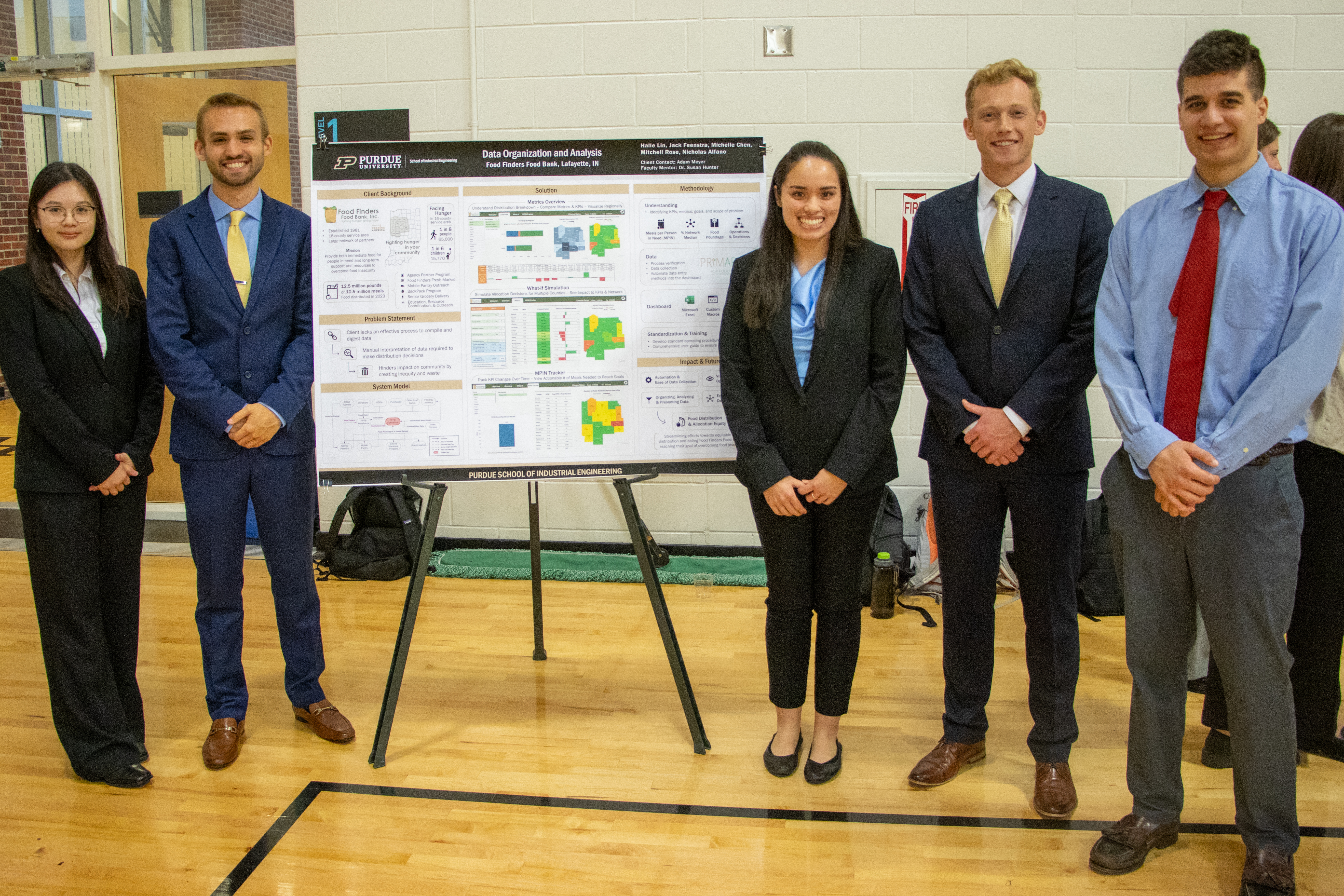
The first-place award went to Team 12 for their work with Lafayette Food Finders Food Bank. The team created an Excel dashboard that allows the operations team to visualize key performance metrics and make data-driven decisions. Team members Nick Alfano, Michelle Chen, Jack Feenstra, Halle Lin, and Mitchell Rose developed their project management skills, coding abilities, and usability design techniques to create a comprehensive dashboard that exceeded client expectations. “Winning first place was so meaningful because it recognized both the hard work of the team on the project and the dedication to our overarching goal of supporting the community,” the team states. “ We’ve developed a solution poised to foster greater equity in food distribution across all 16 counties served by Food Finders. We’re so happy and excited about its potential to expand into a model for food banks nationwide.”
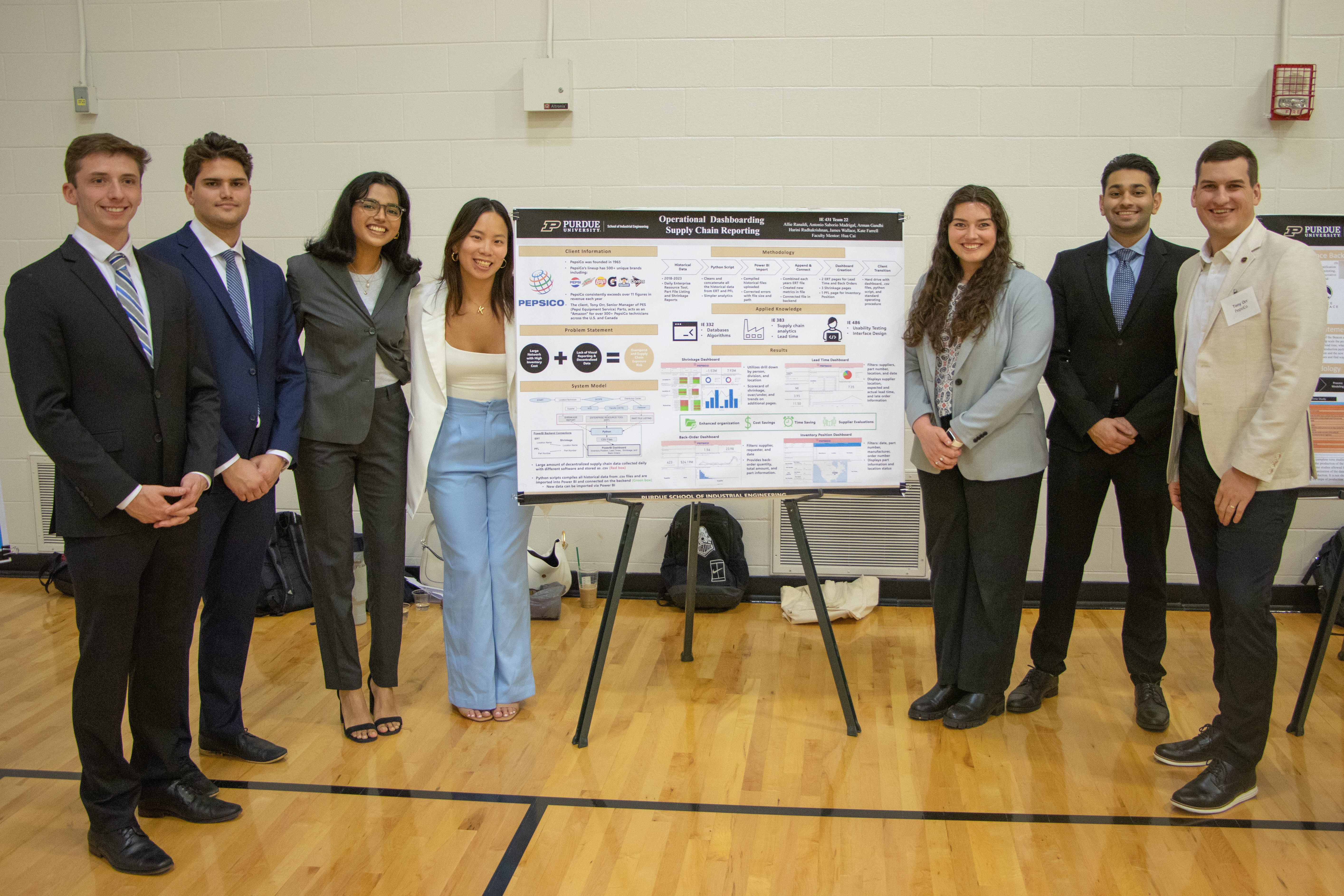
Second place was awarded to Team 8 for their work with Eagle Materials, Inc. Members Mohamed (Mo) Abuelreish , Anvi Arora, John Aspinall, Emma Conklin-Yokel, Kaleb Peters, and Sofia Vonder Haar were tasked with evaluating alternative fuel types for the company’s ready mix trucks that deliver concrete to various construction sites. The team suggested compressed natural gas as an alternative fuel type for a better return on investment and carbon dioxide reduction. They describe the process of working with their client as incredibly rewarding. “Eagle Materials paired the team with fantastic mentors that assisted in ensuring the team was on track,” says Anvi. Emma, who will soon be working in manufacturing with Procter & Gamble, says that the project prepared the team well for experience in industry, especially in the solution exploration process. After graduation, the team members plan on entering a variety of fields, including semiconductors, soda, and consumer packaged goods.
The third-place prize went to Team 9, also for their work with Eagle Materials. Matthew Novreske , Jack Perrotta, Sergio Monge, Aditya Ram Vijendran and Raece Oakeson were asked to develop a site map that shows the optimum stockpile layout for raw materials inventory in a covered storage area. The team created site plans and paths for trucks to unload raw material in specific geometric patterns that would allow for prioritization of old inventory.
The People’s Choice Award, decided by community vote, was given to Team 19 for their work with the Lafayette School Corporation’s transportation system. The team, including seniors Kirsten Brutans , Kendall Kelly, Madeline McNarney , Olivia Murchie, and Andrew Rentz, analyzed and compiled helpful resources for the corporation to provide more effective and efficient bus operations.

Meet Dr. Rachael Fleischaker, Proud Alum now Overseeing the Online Master of Music in Music Education Capstone Research Project at Kent State University

Meet Rachael!
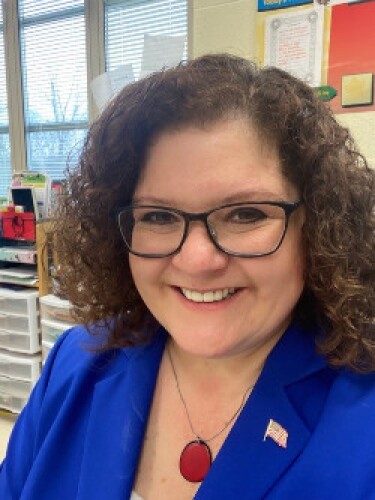
Dr. Rachael Fleischaker is now overseeing the capstone research project for the Online Master of Music in Music Education at Kent State University. She is also a proud alum of the program!
Tell us about yourself and your work/time at Kent State University.
I grew up in a small town in WV. After completing my BME at the College of Wooster, I began teaching elementary music. For the past 25 years, I have taught band, choir, and general music in the elementary and middle schools of Canton City Schools in Canton, OH.
I received my Master’s in Curriculum and Instruction here at Kent in a program that placed special emphasis on urban teaching. Many years later, I decided to begin my doctoral studies in music education. My master’s had opened my eyes to culturally responsive teaching and my dissertation gave me the opportunity to study it in-depth and research the ways it is perceived and applied to music education.
What drew you to music?
In high school, I began to play the oboe. I studied with Dr. Nels Leonard of the Wheeling Symphony. He was a wonderful coach and was the first person to encourage me to think about a career in music. In college, Nancy Ditmer was my mentor who not only supported me through my studies but as a female conductor was a wonderful role model.
What are you looking forward to most in your new role (overseeing the program capstone project)?
I am very excited to work with the wonderful faculty and staff in the MME program. I had such a positive experience throughout my doctoral work that it is nice to continue those relationships and already I am building more relationships with very supportive and enthusiastic people. I am also excited to work with the master’s students and see what types of Capstone projects they create.
Why should students choose this program?
That is a good question. I would say that getting a master’s degree is the right move for any teacher, but especially for music educators. In undergraduate studies, students are working on such a broad range of topics - becoming an expert on a given instrument, music theory, history, pedagogy, performing ensembles; not to mention the requirements for a teaching license - child psychology, teaching methodologies, behavioral management strategies and so on. It can be quite overwhelming. Once a person has had a few years of teaching experience, strengths and weaknesses become more clear. A master’s program allows teachers to ask educated questions and really personalize their studies so they can become a “master’s” teacher.
Why choose the Kent program?
Because you can get all the benefits of a master’s degree with the convenience of online coursework. You can tailor your studies to your specific needs and work in a timeframe that suits your busy teaching schedule.
What was a favorite memory of your time in the MMME program?
I have to laugh at that question because when I was ready for a master’s degree, Kent did not have an online program. Today’s students may not believe this, but I finished my undergraduate degree without owning a computer or a cell phone! Perhaps, that is why I am so excited (and amazed) that Kent State can offer such a high-quality program in such an accessible manner.
What podcast are you currently listening to or what book are you currently reading?
My podcast listening varies greatly. I mostly listen to NPR or other news-related podcasts in the car on the way to and from school. I was so busy reading books about music education during my doctoral work over the last year and a half, I have been working through a large stack of books by my bedside table. They were put there for “when I have the time”. Now that I do, I have really enjoyed some good fiction. The last book I read was Amor Towles, The Lincoln Highway.
What’s your favorite part about higher education?
My favorite part has to be the students. I am passionate about music education! I love to see how the next generation is reacting, interacting, and transforming the profession for future music students!
Learn more about Dr. Fleischaker.
Rachael Fleischaker teaches general music, beginning band, and elementary choir at AIM Academy in Canton, OH. She has also taught undergraduate coursework for Baldwin Wallace University, The College of Wooster, Kent State University, and The Ohio State University Mansfield Campus. She holds a Bachelor of Music Education degree from the College of Wooster and a Master of Education degree in curriculum and instruction from Kent State University.
Rachael earned her Ph.D. in Music Education from Kent State University. Her dissertation, Culturally Responsive Music Education: Conceptual and Practical Approaches of Elementary General Music Teachers, focused on how general music teachers understood and subsequently put into practice culturally responsive teaching. Rachael has published Text Sets: Multimodal Learning for Multicultural Students (Brill Sense Publishers, 2016) in collaboration with Dr. Joanne Dowdy. She has twice won the Kent State University Excellence in Performing Arts Research. Her research papers, Student Assessment in the Ohio Teacher Evaluation System (OTES): Is It Improving Instructional Practices in the Music Classroom? and Accumulating Capital in Music Education: A Content Analysis of the Music Educators Journal from 2011 to 2016 can be accessed in the Excellence in Performing Arts Research online journal. She also has several articles published in TRIAD.
Rachael enjoys presenting at local, state, and national professional development venues. She is a frequent clinician at the Ohio Music Education Association’s annual professional development conferences and has presented at the National Association for Music Education conference. Topics at these events have included culturally responsive teaching in the music classroom, social justice issues in music education, working with special needs students, the Ohio teacher evaluation system, and general music repertoire.
Rachael currently serves as the chair of the OMEA Teacher Evaluation Committee and serves on the Diversity, Inclusion, Equity, and Anti-Racism (DIEA) committee. She serves on the Ohio Department of Education Fine Arts Advisory Committee for the 2022 Fine Arts Revision. She also serves on the Stark County Educational Service Center Lead Music Teacher Planning committee.
Rachael’s work in the Kent University Master of Music Education program stems from her belief that all students deserve the very best music education possible. Daily interaction with students of any age keeps her motivated to develop as a music teacher, professor, and role model. The doctoral pursuit was challenging, but the struggles have helped her to relate to her students and to grow as a professional.
Rachael lives in Massillon, OH with her husband Dan. They have four children and two dogs.
Enroll today in the Online Master of Music in Music Education Program at Kent State University
The Online Master of Music degree in Music Education program is designed to offer music teachers the opportunity to develop and refine their professional skills. The degree program allows for enhancement and specialization relative to music teaching and learning in contemporary school contexts.
Kent State University is synonymous with music education. Some of the leading voices in the field have earned a degree here. Our 100% online program can be completed in as few as 23 months. Our curriculum is created for the music teaching professional. Classes are 7 weeks and you can enroll in two classes per semester, including summer. This format allows you to focus on one area of study and then begin another music education course after a brief recess. We are dedicated to helping you design a program that provides you with exciting new perspectives in your teaching right from the beginning.
For more information on Kent State’s Online Master of Music in Music Education, visit https://onlinedegrees.kent.edu/degrees/master-of-music-in-music-education

Industrial, Manufacturing, and Systems Engineering
- IMSE Students
- Faculty Directory
Spring 2024 Senior Capstone Projects in Industrial, Manufacturing, and Systems Engineering
Spring 2024 - industrial engineering capstone design, ariat international: forklift charging area optimization.
Our project serves as a testing ground for lean systems implementation starting with the Forklift Charging Station at the West Park facility. Our role was to design an intuitive and effective layout for the station while improving operations. Through an analysis consisting of 5 whys, pareto charts, and fishbone diagrams, we implemented various organization tools to aid in the productivity and organization of the area. Our project yielded an improvement of 65% using 5S assessment as a metric and has established a culture aimed at continuous improvement.

Gatekeeper Systems: Time Study Analysis and Production Line Balancing
Gatekeeper recently moved their manufacturing line and added/subtracted different processes to start producing a newer model. These factors along with exponential company-wide growth and an ever-changing workforce has led to a less than optimally balanced production line. Our team pitch to Gatekeeper included adopting radios for each worker, adding a floating employee, and rebalancing the manufacturing line. After implementation, we estimate a decrease in total cycle time translating to an additional three units being made per day.
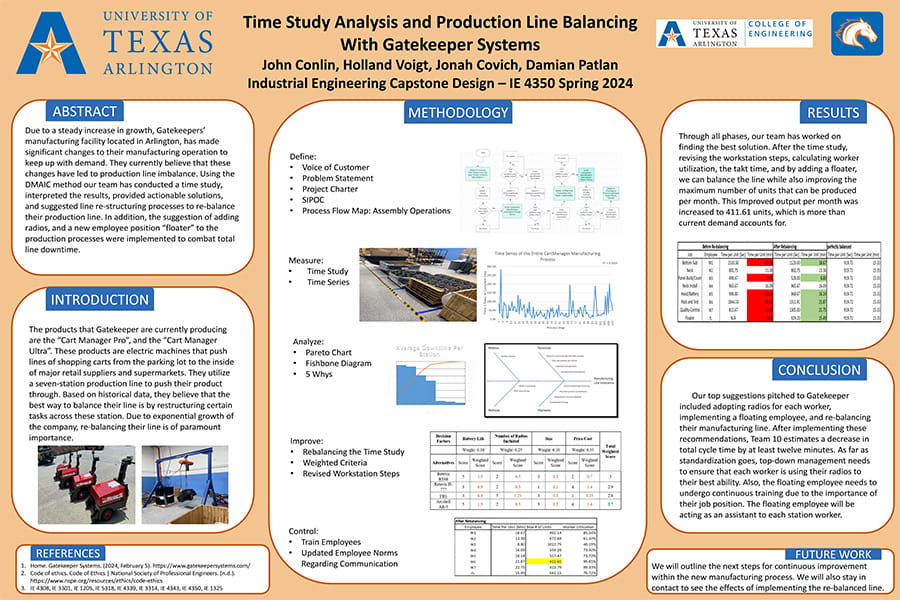
Klein Tools: Improving Efficiency of Cleaning and RP for Pliers/Wire Strippers

Klein Tools: Screwdriver Blade Production Operation Improvement
Our project aims to enhance efficiency in the bolstering and finning operations through application of the DMAIC process methodology. Leveraging industrial engineering tools and meticulous data collection, the project focuses on addressing observed inefficiencies. Analyses found that nonadjustable layout, wasted movements, and non-value-added processes were at the root of low station throughput. Processes were redesigned, tested, and recorded via standard work, and an improved layout was implemented. After improvements, a 48% production increase was found for bolstering and a 62% production increase for finning.

MSL Racing LLC: Layout and Process Improvement for Paddock Facilities
MSL Racing offers a range of services including private driver coaching, karting consulting, parts and service, and trackside race support. Currently, they do not have a consistent paddock layout for different-size karting events leading to economic inefficiencies, lack of professionalism, and process flow issues. Our team used the 5 Whys technique, an Ishikawa diagram, and process mapping to understand the process and explore potential causes for paddock inefficiencies and performed several time studies for setup/teardown process. This data was interpreted to establish key areas for improvement. We analyzed cost and revenue data from events and designed a template with a CAD model for 6, 8, and 10 kart layouts while maximizing space utilization and maintaining high quality of service. We developed a standardized set of instructions for setup/tear down which has reduced time and labor. Utilization increased across the board for service such as pit stalls, walkways, hospitality, food, data, and tire station. Based on customer feedback the new layouts and setup/teardown instructions have been a great improvement to overall performance, organization, and professionalism of the team.
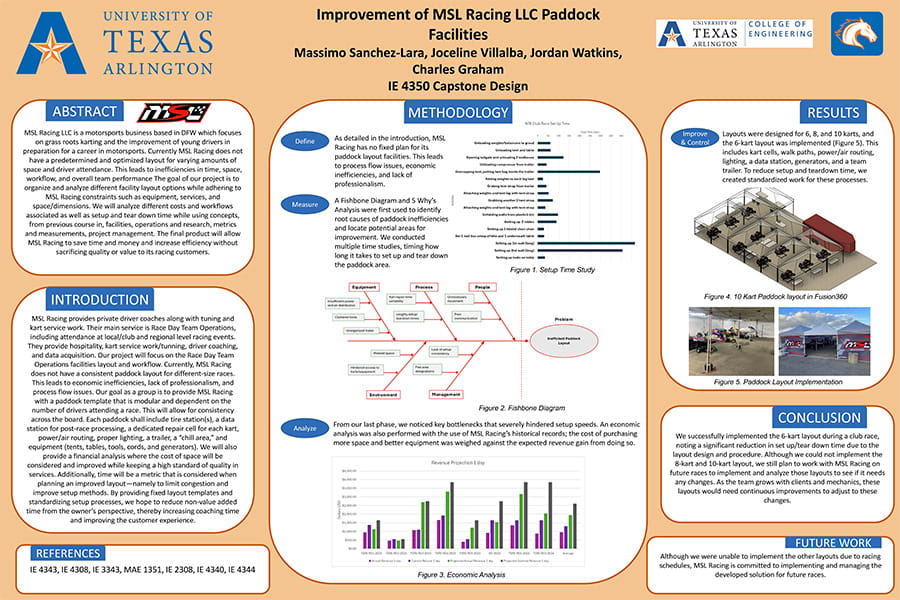
National Door Industries Frame Assembly Line Balancing
Our project is to study a potential new washer system which will avoid having operators exposed to harsh chemicals as an improvement to hand washing the frames manually. We will evaluate how adding this washer system will impact the rest of the frame assembly line through various analyses, design a balanced line and standard work, and determine if throughput will be affected. We have been able to successfully provide National Door Industries, Inc. with multiple design recommendations for improvement and methods to ensure that the impact resistant frames (IRF) line is continuously improving. When implemented they will have a huge effect on cost efficiency. Rebalancing the line for two operators who will work the most value-added tasks justifies the cost of both operators.

Treasures of Magic: Layout Design for Effective Packaging Area
Treasures of Magic, an online magic trick store has set up a website for selling products but needs a packaging space to prepare items for shipment as they currently do not have one. This project has designed a packaging system and storage/work area that will establish an efficient and effective flow.
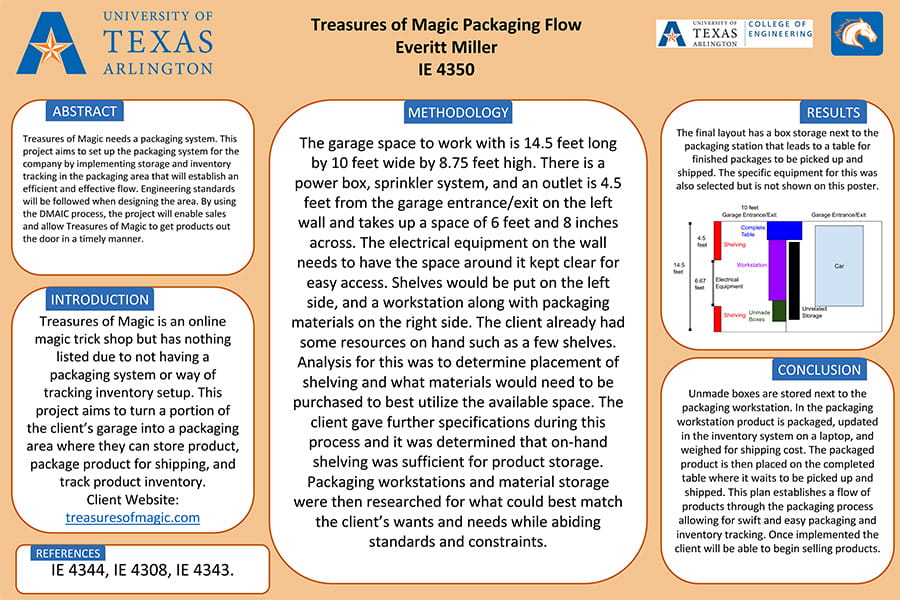
UTA Library Special Collections: Layout and Process Optimization
The UTA Special Collections (SPCO) division of the UTA Library confronts critical inefficiencies over the past fifty years leading to operational bottlenecks. Our project has tackled these issues head-on by using DMAIC. After conducting time studies to gather data on the current state of operations, we have identified specific areas where time was being lost. Our findings revealed that careful reorganization could lead to a significant decrease in wasted time. The newly designed SPCO layout has led to a remarkable 30.43% reduction in the travel time of catalogers. This efficient configuration signifies a leap forward in the operational workflow and promises a more effective use of the archival space.

- Undergraduate Advising
- Graduate Advising
- Degree Plans and Certificates
- Advisor Contact Form
- Capstone Design Projects
- 2024 Spring Projects
- 2023 Fall Projects
- 2023 Spring Projects
- 2022 Fall Projects
- 2022 Spring Projects
- 2021 Fall Projects
- 2021 Spring Projects
- 2020 Fall Projects
- 2020 Spring Projects
- 2019 Fall Projects
- 2019 Spring Projects
- 2018 Fall Projects
- 2018 Spring Projects
- 2017 Fall Projects
- 2017 Spring Projects
- 2016 Fall Projects
- 2016 Spring Projects
- Undergraduate Research
Mail & Deliveries
Box 19017 UTA Arlington, TX 76019
Woolf Hall Room 420 500 West First Street Arlington, TX 76019
Phone, Fax, & Student Apps
- Phone: 817-272-3092
- [email protected]

COMMENTS
The capstone project is a unique opportunity to carry out independent group research in order to devise an innovative solution for a real-world problem. While a project of this scope and scale can be challenging, it can also be very rewarding. The capstone project is usually the final assignment and plays a vital role in preparing students for ...
Step 7: Go over your paper one more time. Review and make necessary revisions to your paper. Check for clarity, completeness, and coherence. Ensure that your outline reflects the scope and depth of your project. 💡 Extra tip: Seek feedback from your capstone project supervisor, peers, or mentors.
A capstone project in college is a final independent project undertaken in a program of study designed to assess the skills, knowledge, and expertise acquired by the student. As the name suggests, it is the capstone or crowning achievement of academic life and the last class taken before graduation. It gives you the final credits required to ...
A capstone project is a multifaceted academic experience typically required for students during the final year of an academic program. It is a comprehensive and interdisciplinary project that often requires students to apply the knowledge and skills acquired throughout their academic careers to solve real-world problems or issues.
A capstone experience is the culmination of a student's study in a particular major. A capstone experience at Stanford encourages students to "integrate knowledge and skills developed in the major and to learn and think independently with the tools of the discipline.". Examples include an honors thesis, senior paper or project, and capstone ...
A Logic Model is a graphic depiction, or road map, that presents the shared relationships among resources, activities, outputs, and outcomes/impacts of your capstone project's activities. The intended effect of a Logic Model is the "if-then" relationship among the project's elements (Centers for Disease Control and Prevention [CDC], 2018).
4.2 An abundance model of re ection to identify a capstone project topic 40. 4.3 Clarifying research questions 46. 5.1 The outline of Chapter 5 50 . ... Capstone projects, however, are also very ...
Capstone projects are generally designed to encourage students to think critically, solve challenging problems, and develop skills such as oral communication, public speaking, research skills, media literacy, teamwork, planning, self-sufficiency, or goal setting—i.e., skills that will help prepare them for college, modern careers, and adult life.
The capstone project in college is the apogee, or completion marker, of a student's coursework leading to the culmination of their program with a degree in their chosen field of study. ... a capstone may include anything from a video presentation or an architectural model to an art exhibit or short film; however, it almost always includes a ...
Starting with the graduating class of 2025, all Stanford undergraduates are required to complete a capstone project as part of their major (see capstone.stanford.edu).. Capstones have been identified as a high-impact educational practice, providing opportunities for students to integrate and apply what they have learned during their major courses of study, strengthen relationships with ...
While a capstone and thesis serve similar functions, most MBA programs distinguish between the two projects. MBAs typically include practicum/internship components, enabling students to gain hands-on experience in professional business environments. Capstones build on this experience, requiring students to develop practical solutions to real ...
Completing Your Nursing Capstone. Capstone formats and completion times widely vary between programs. Students at Luther College and Purdue University Northwest complete their capstones in 4-5 weeks, while Ferris State University specifies a timeframe of 30 hours of online classes and 90 hours of applied project work.
The following are research methods commonly used in capstone research: Case studies. Case studies are in-depth investigations of a single individual (noteworthy sustainability leader), a group (activist), or event (United Nations Framework Convention on Climate Change). Reading prior case studies is a must to inform your design.
Unique Analytics Capstone Project Model. Ideas Made to Matter—that's what Sloan cares about, and it's what we embody in the MBAn program. Our students represent the top potential in the analytics field, and we make sure that their ideas and their solutions have meaningful impact for our business partners. A highlight of the Master of ...
An example of how one DNP student followed this 5-step evidence-based process to develop a change project with the goal of increasing vaccination among healthcare personnel working in a college: Step 1. A change project was initiated to increase influenza vaccination among healthcare personnel at a college. Step 2.
Even a moderately sized capstone project CAD model can contain hundreds of parts, assemblies, subassemblies, drawings, and other data. With traditional CAD, managing this data quickly becomes a full-time job. Keeping track of files, versions, and iterations can grind the design process to a halt. Onshape seamlessly handles the data management ...
Explain the purpose of planning models in capstone projects. Compare and contrast theoretical frameworks, conceptual frameworks, and planning models. Describe at least two ways that a theoretical framework can strengthen a capstone project. Utilize strategies to select an appropriate framework or model for your capstone project.
Reading, examining, studying, summarizing, and integrating research completed by others with the intent of answering an original thesis question or supporting other scholarly or service related work. Ogden, Utah 84408. 1-801-626-6000. Contact Us En español.
Agile/Scrum is a philosophy and methodology for improving performance on complex projects. While largely used in software development, this approach to project management can be applied to projects in any field. Agile/Scrum focuses on transparency, adaptability, individual team member autonomy, accountability, and continuous improvement.
This paper describes the application of the L.E.A.D. leadership model in capstone design projects in the Naval Architecture and Marine Engineering program at the U.S. Coast Guard Academy. The L.E.A.D. framework champions a reflective learning model achieved through frequent quality facultystudent - interactions and mentorship.
COs and POs mapping for Capstone project (prototype developed with an emphasis on environment and sustainability)is shown in Table 3. Sample capstone project titles and its relevance and their contribution towards attainment of POs are listed in Table 4.As per evaluation scheme, marks break up with respect to COs is presented in Table 5.
21 Interesting Data Science Capstone Project Ideas [2024] By Mohini Saxena. Data science, encompassing the analysis and interpretation of data, stands as a cornerstone of modern innovation. Capstone projects in data science education play a pivotal role, offering students hands-on experience to apply theoretical concepts in practical settings.
To associate your repository with the capstone-project topic, visit your repo's landing page and select "manage topics." GitHub is where people build software. More than 100 million people use GitHub to discover, fork, and contribute to over 420 million projects.
The group discussed how their project demonstrated how machine learning could be used to help predict illegal fishing, information that could, potentially, reduce its prevalence. Like any complex challenge, completing a capstone project can be stressful. And in those difficult times, sources of wisdom are sometimes found in unexpected places.
The 12th annual Engineering Project Showcase at Texas A&M University included over 300 teams of 1,400 students presenting their senior capstone design projects and competing for top prizes. The event, which was hosted at the Zachry Engineering Education Complex, brought together 170 industry judges to observe a year's worth of dedicated work ...
Six students from the Harvard John A. Paulson School of Engineering and Applied Sciences (SEAS) were recognized with the Dean's Award for Outstanding Engineering Projects at the recent SEAS Design and Project Fair at the Science and Engineering Complex. Recipients participated in ES100, a year-long capstone course for seniors in the SB engineering program, where each student develops a ...
To identify the most vulnerable communities, seven UCLA students developed climate models as part of their capstone project for their environmental science bachelor's degree. This spring they traveled to Tobago — the smallest of the two islands that make up the nation of Trinidad and Tobago — to collect on-the-ground data to test the ...
Second place was awarded to Team 8 for their work with Eagle Materials, Inc. Members Mohamed (Mo) Abuelreish, Anvi Arora, John Aspinall, Emma Conklin-Yokel, Kaleb Peters, and Sofia Vonder Haar were tasked with evaluating alternative fuel types for the company's ready mix trucks that deliver concrete to various construction sites. The team suggested compressed natural gas as an alternative ...
Dr. Rachael Fleischaker is now overseeing the capstone research project for the Online Master of Music in Music Education at Kent State University. She is also a proud alum of the program! ... professor, and role model. The doctoral pursuit was challenging, but the struggles have helped her to relate to her students and to grow as a professional.
Spring 2024 Senior Capstone Projects in Industrial, Manufacturing, and Systems Engineering. Spring 2024 Senior Capstone Projects in Industrial, Manufacturing, and Systems Engineering. Events; ... We analyzed cost and revenue data from events and designed a template with a CAD model for 6, 8, and 10 kart layouts while maximizing space ...